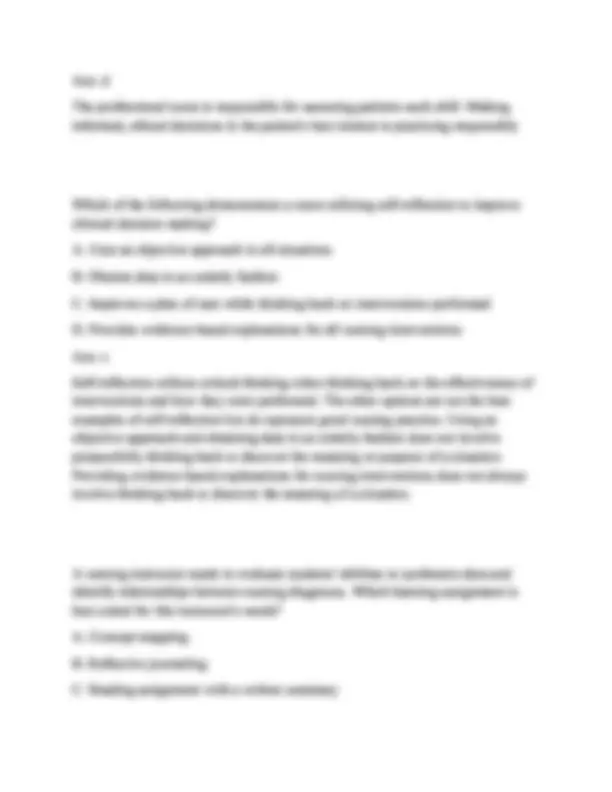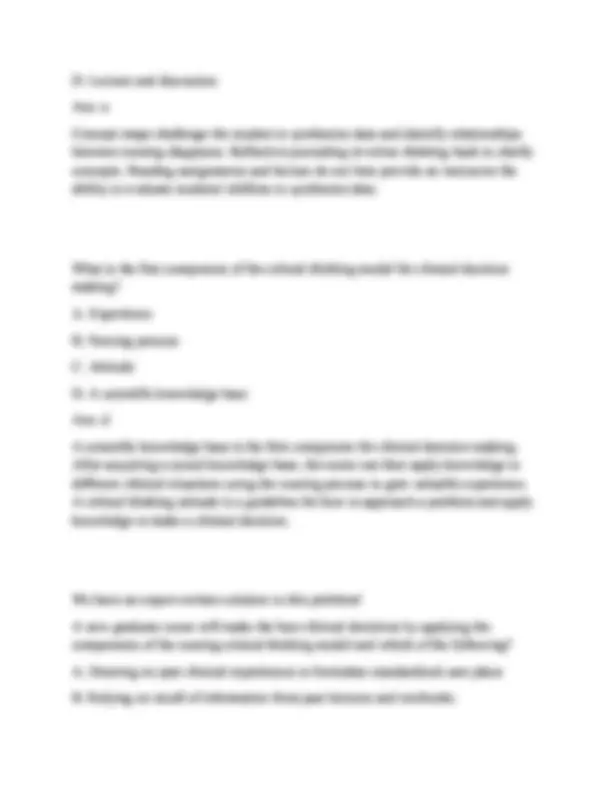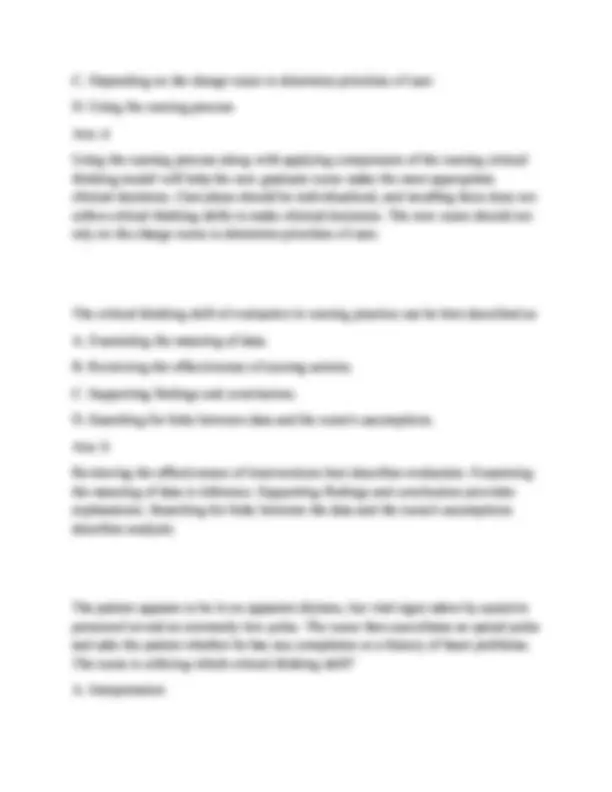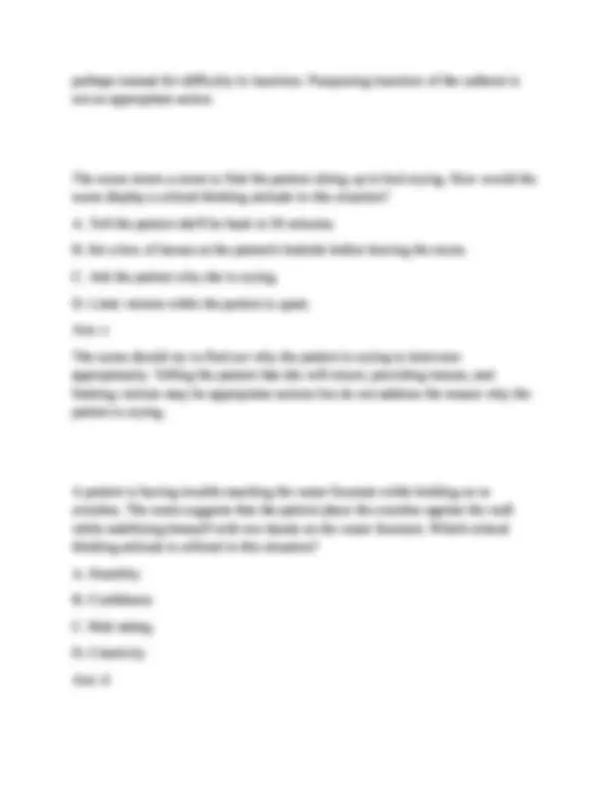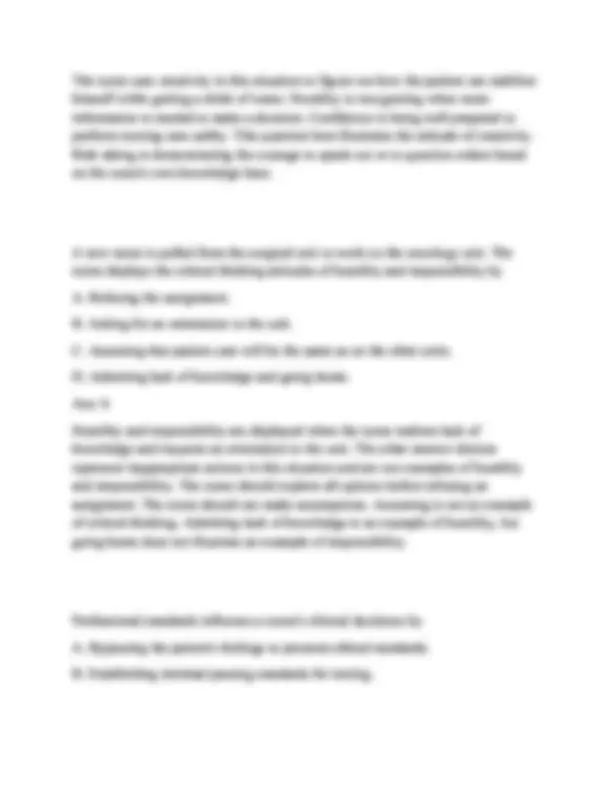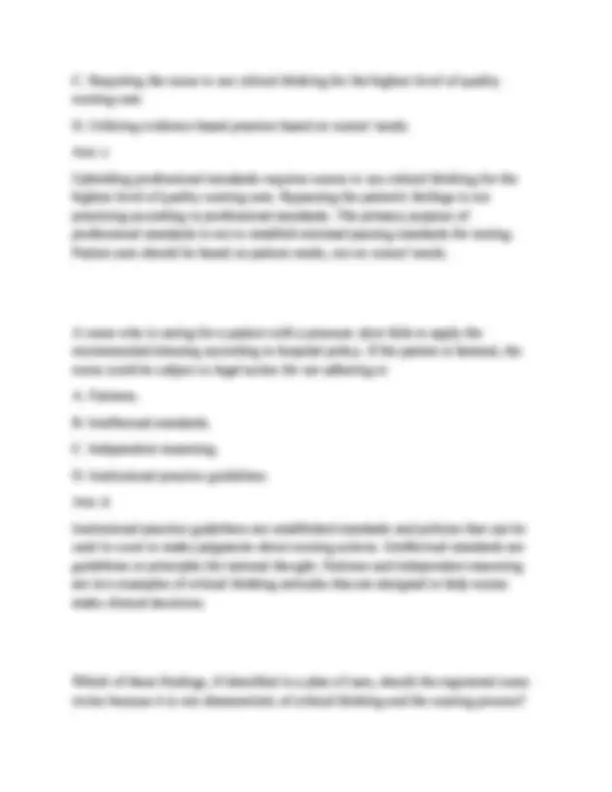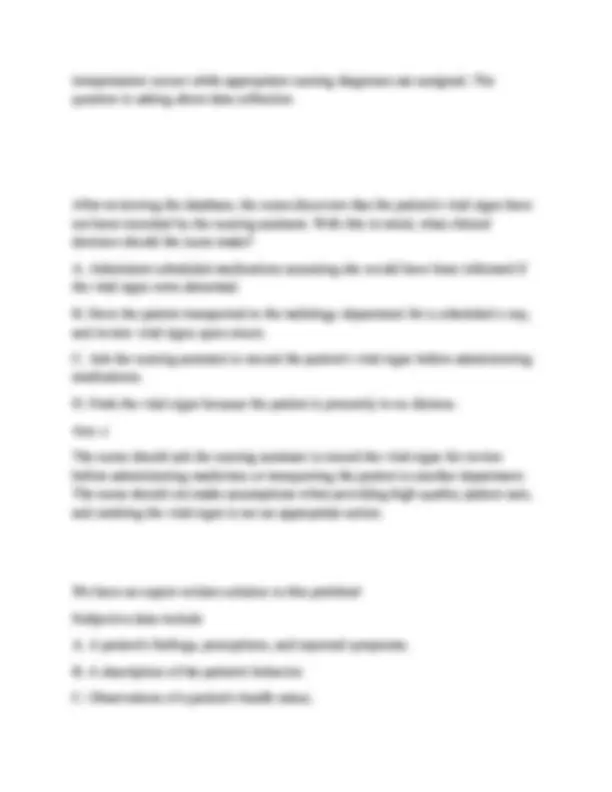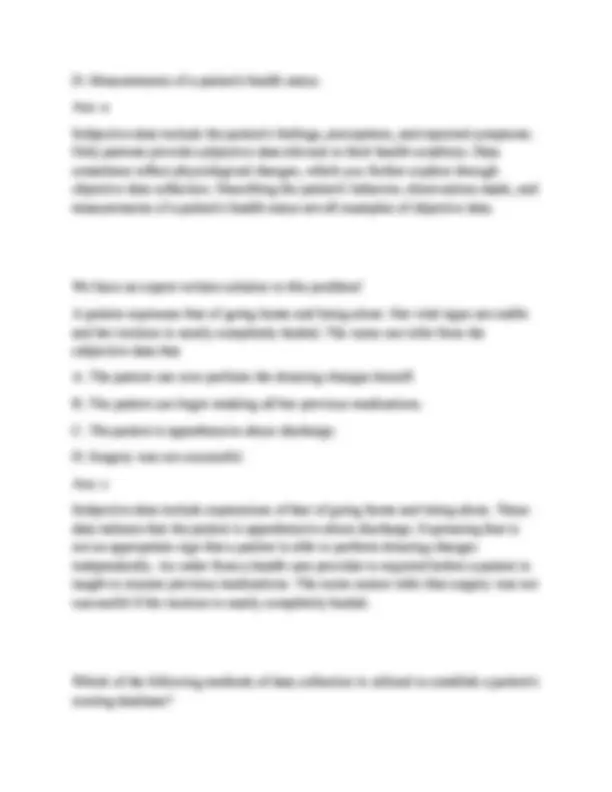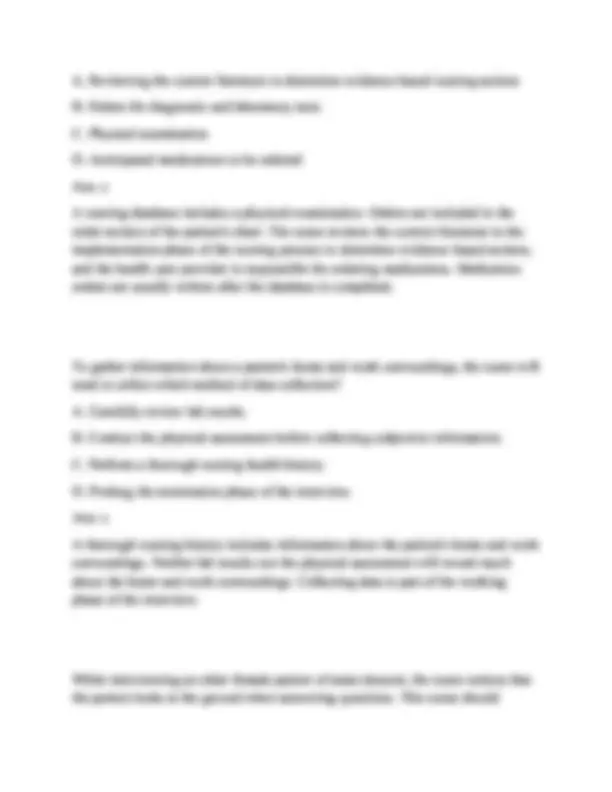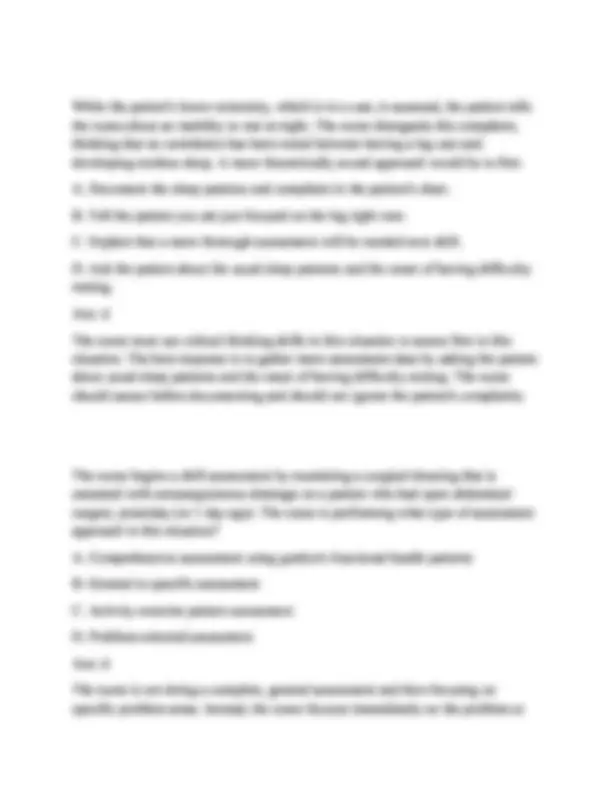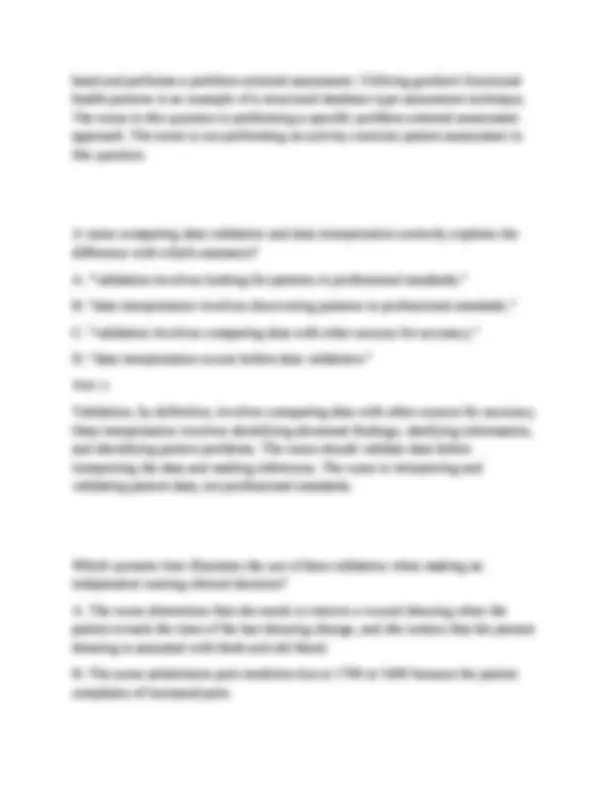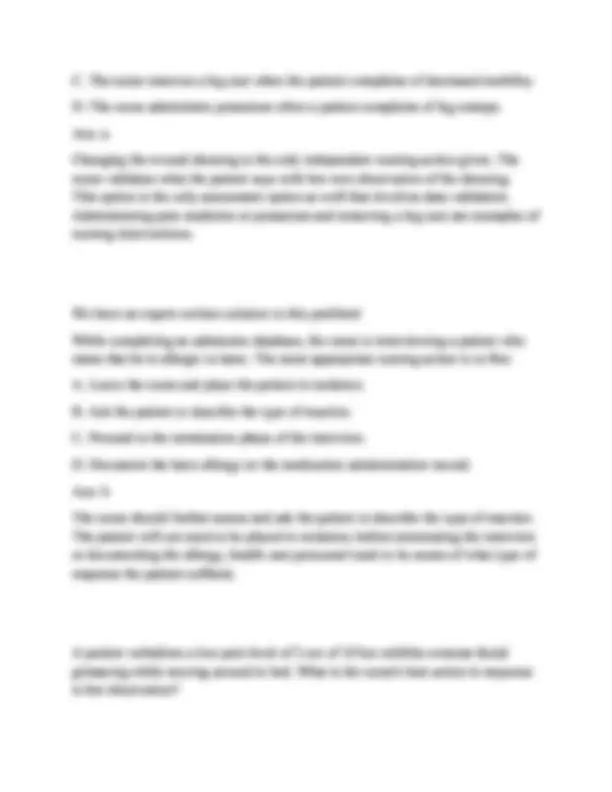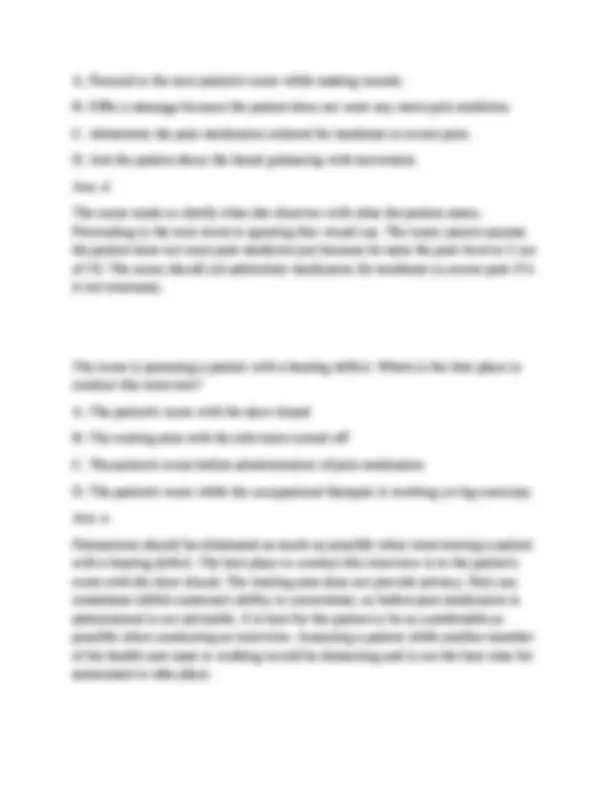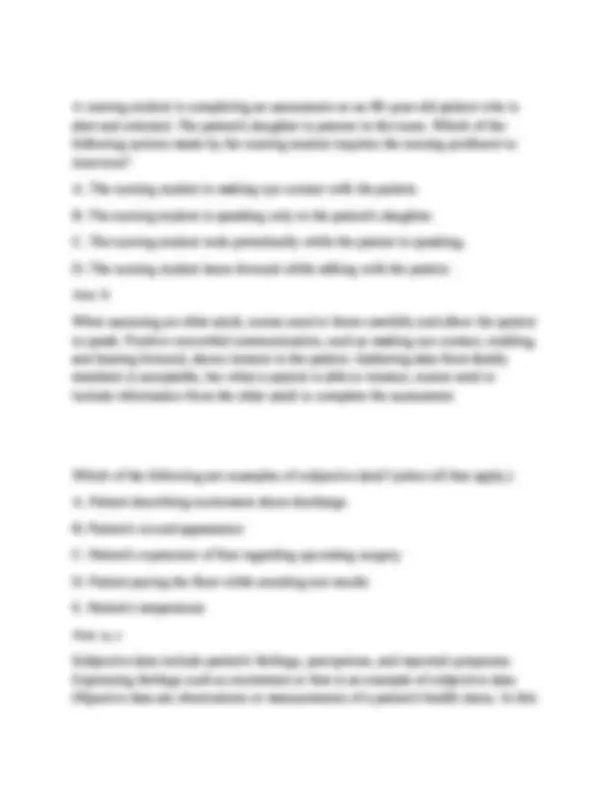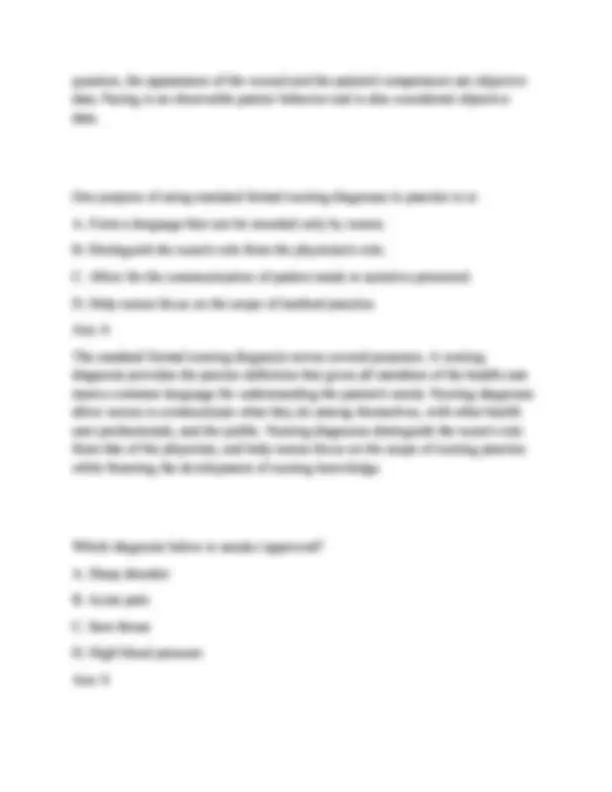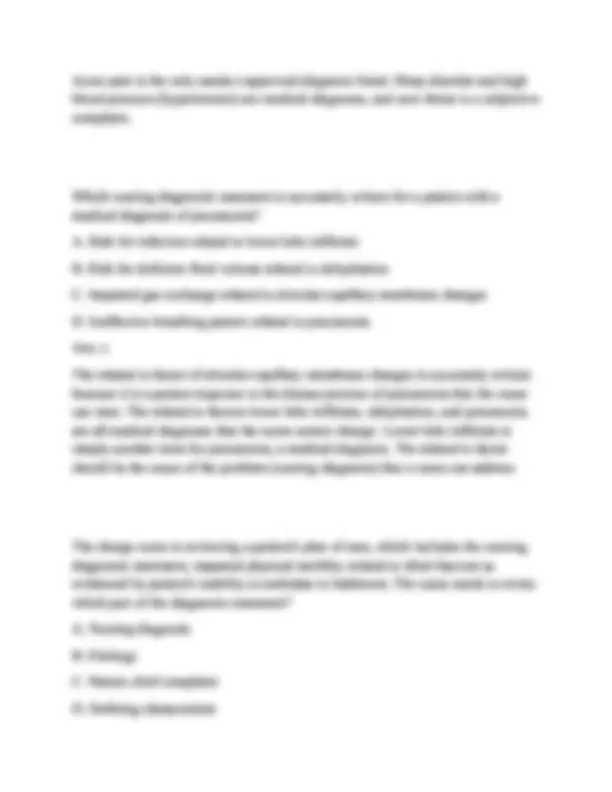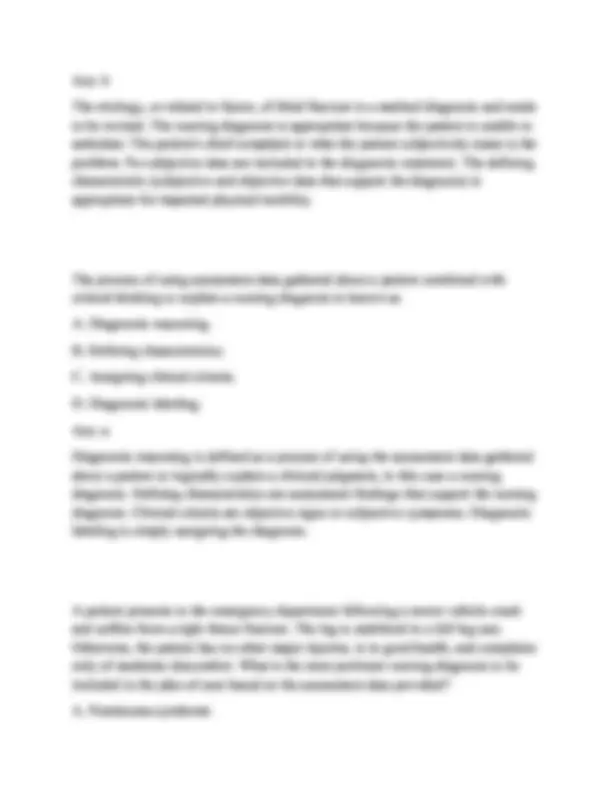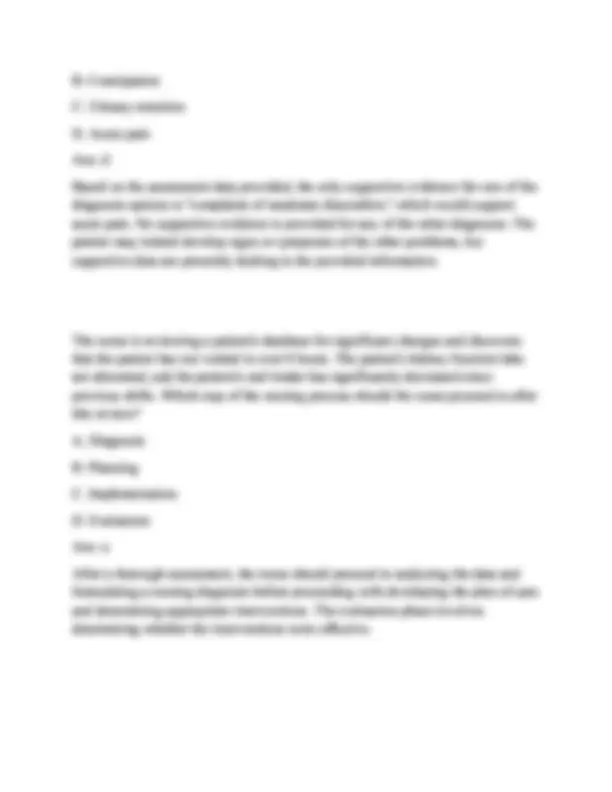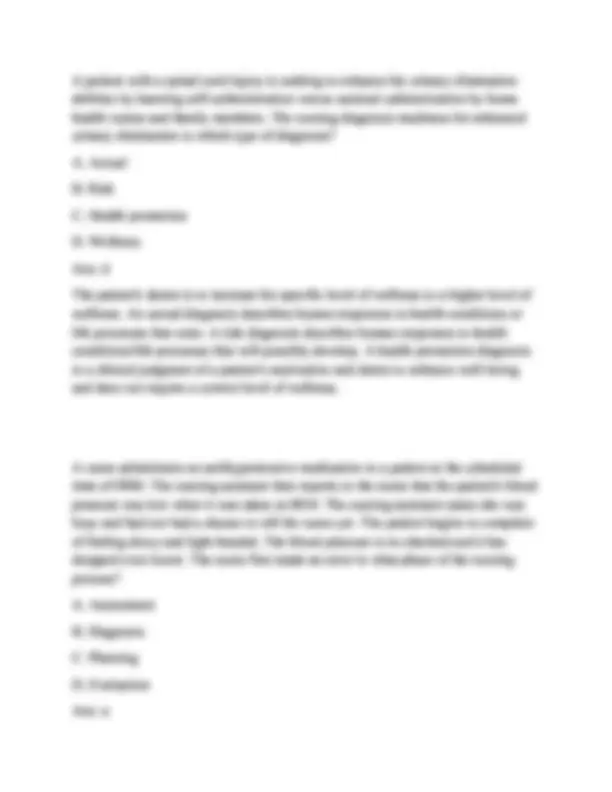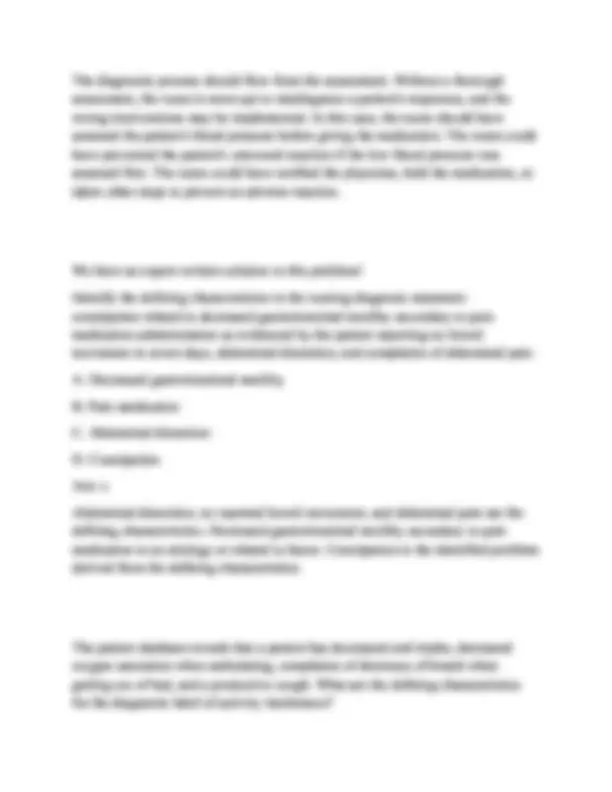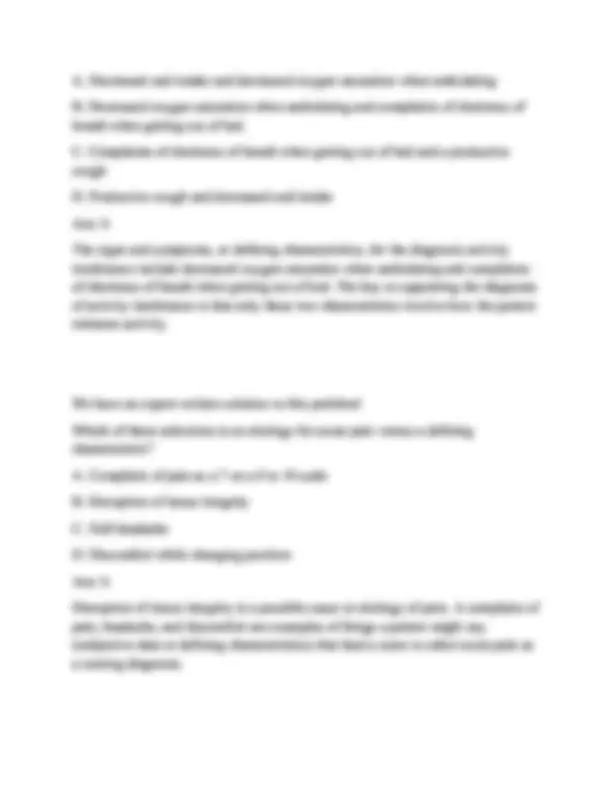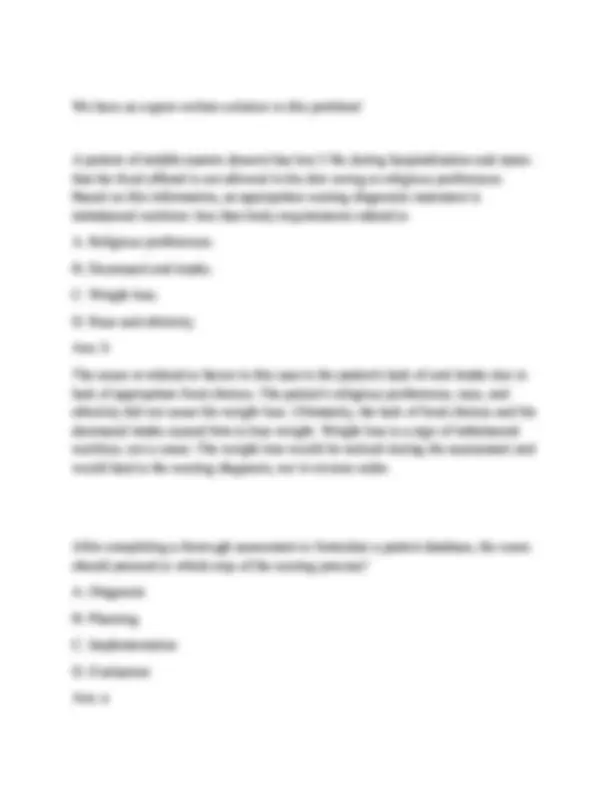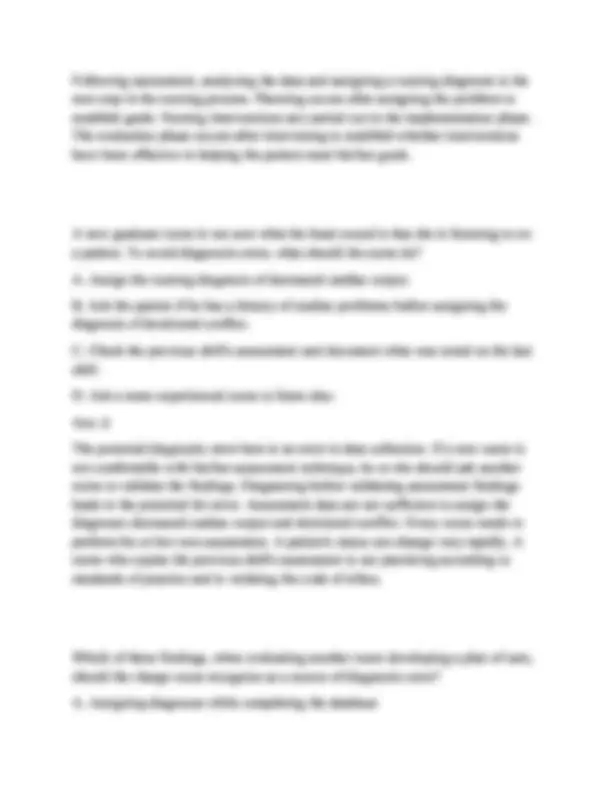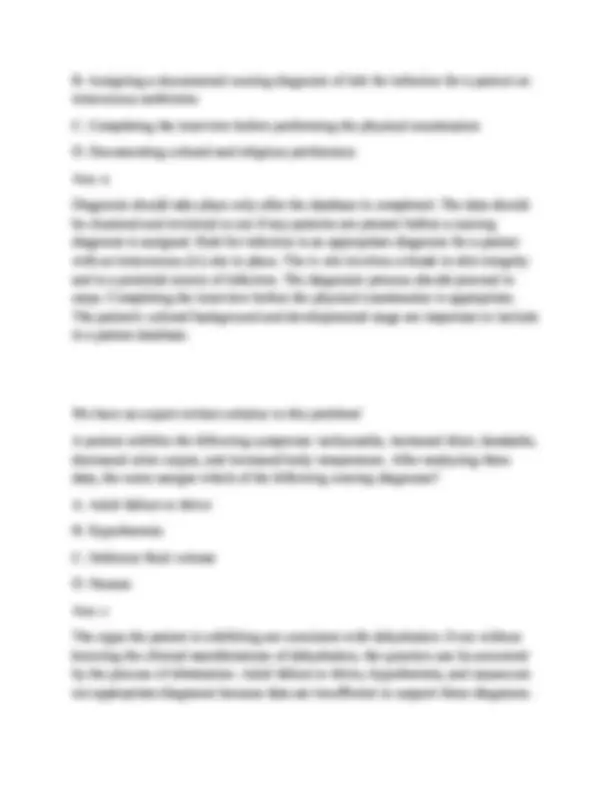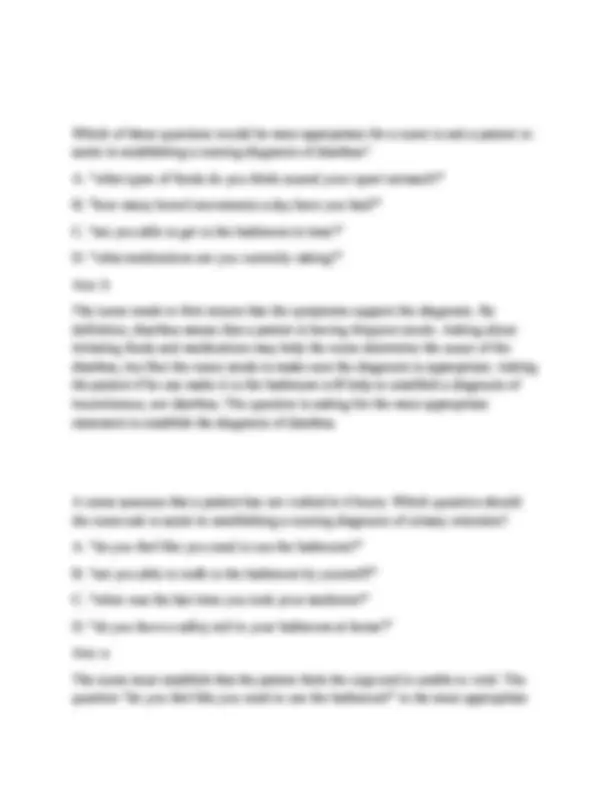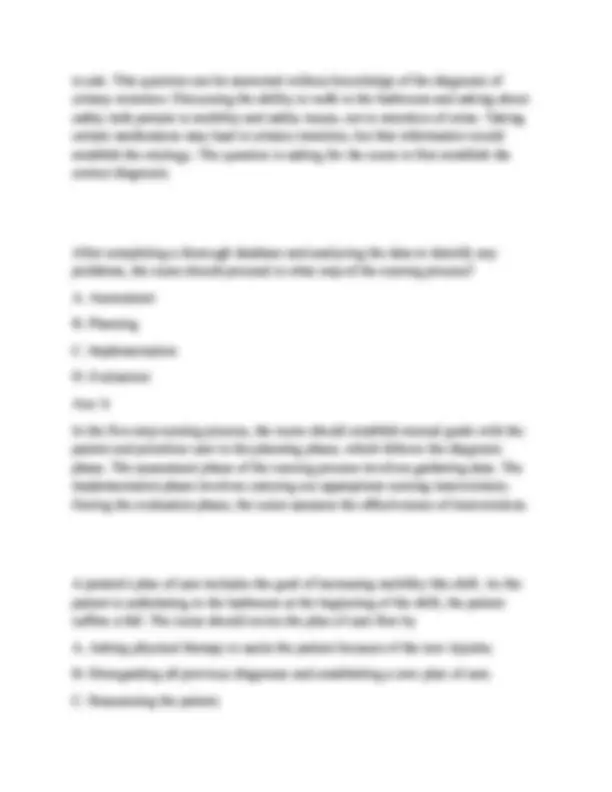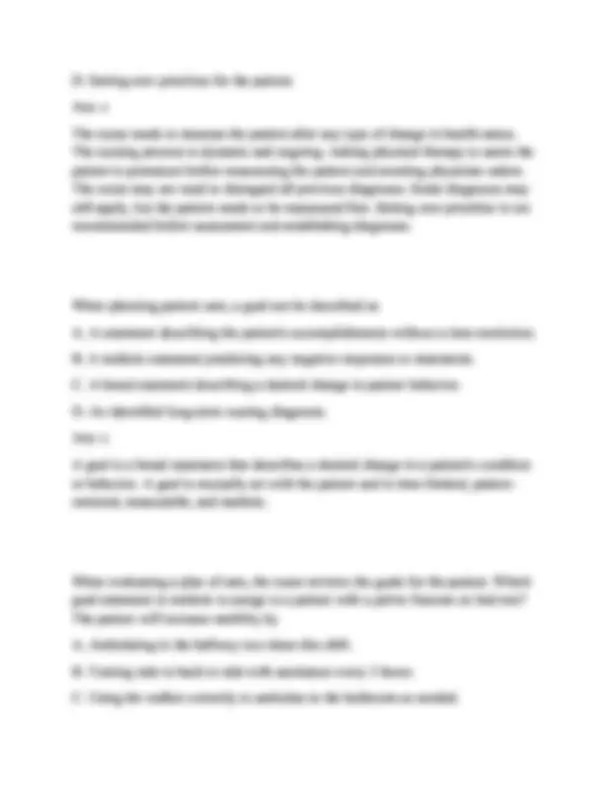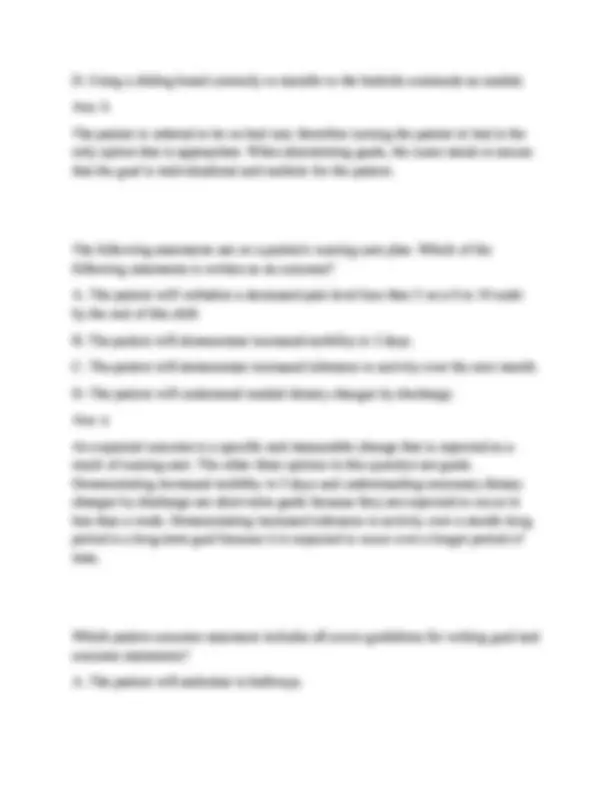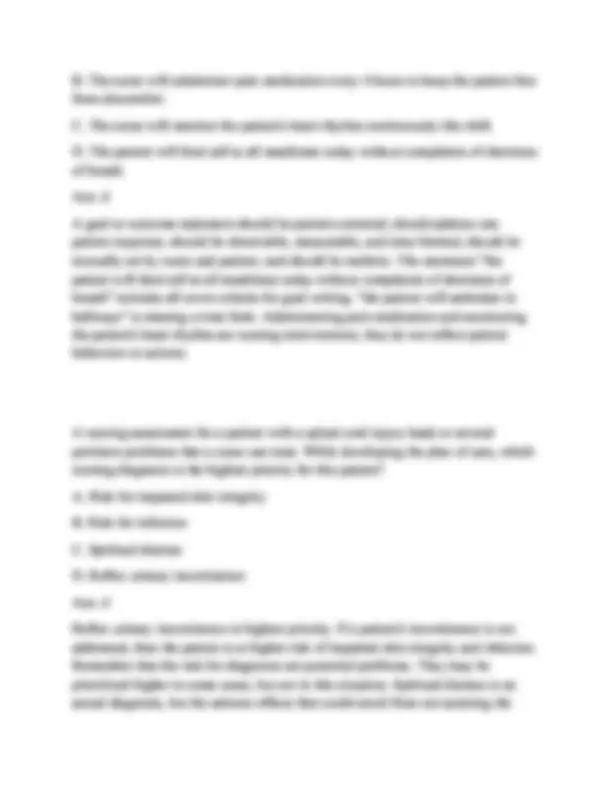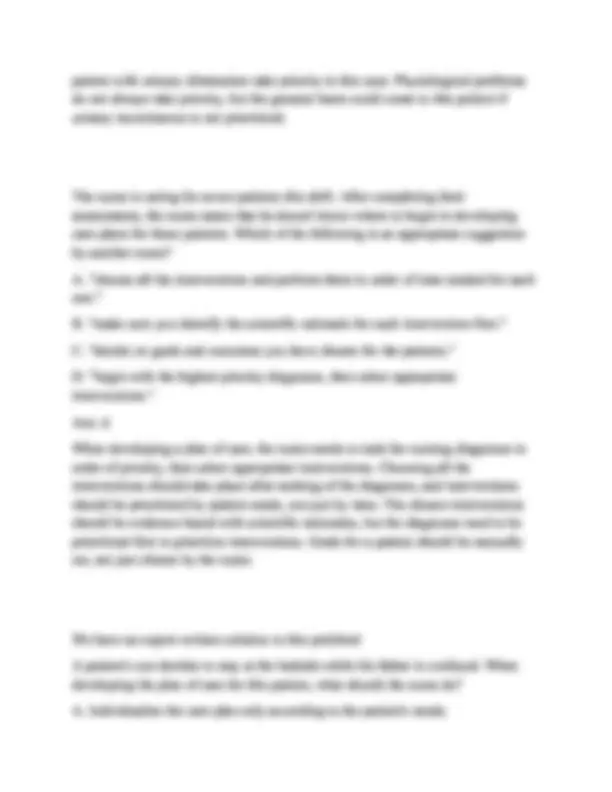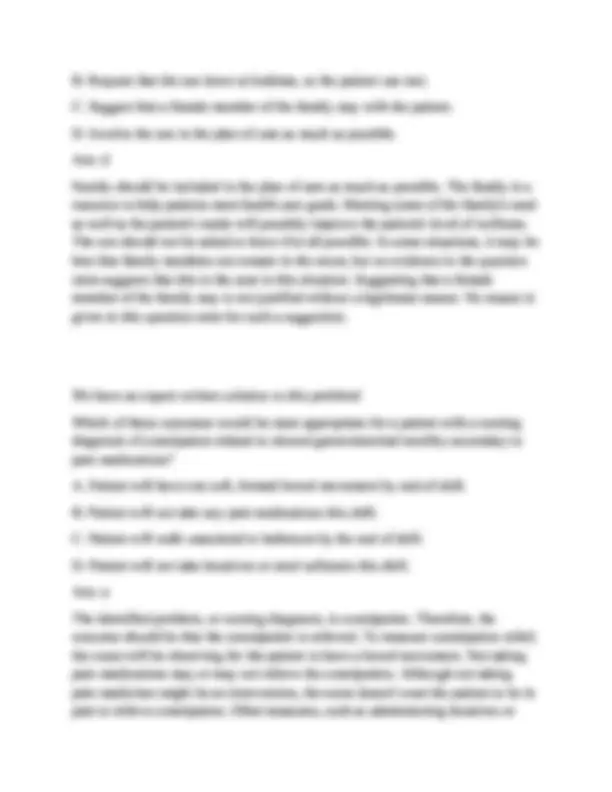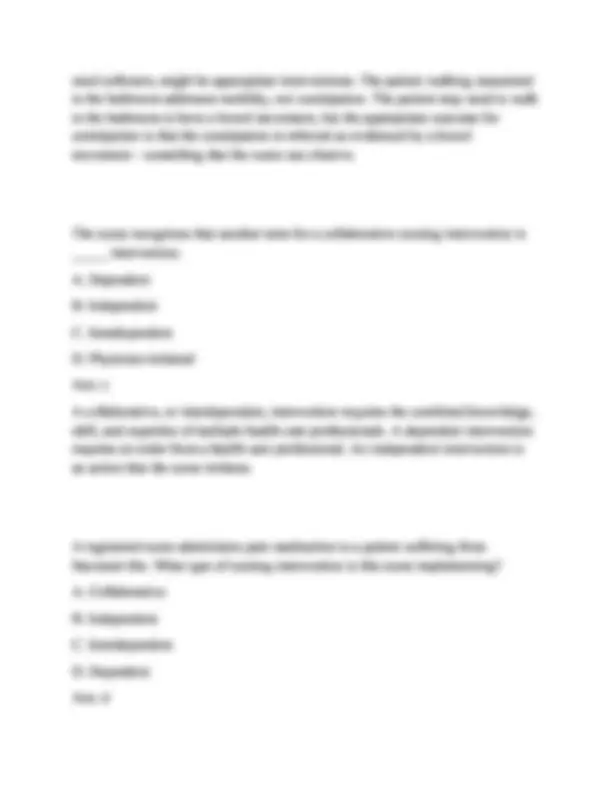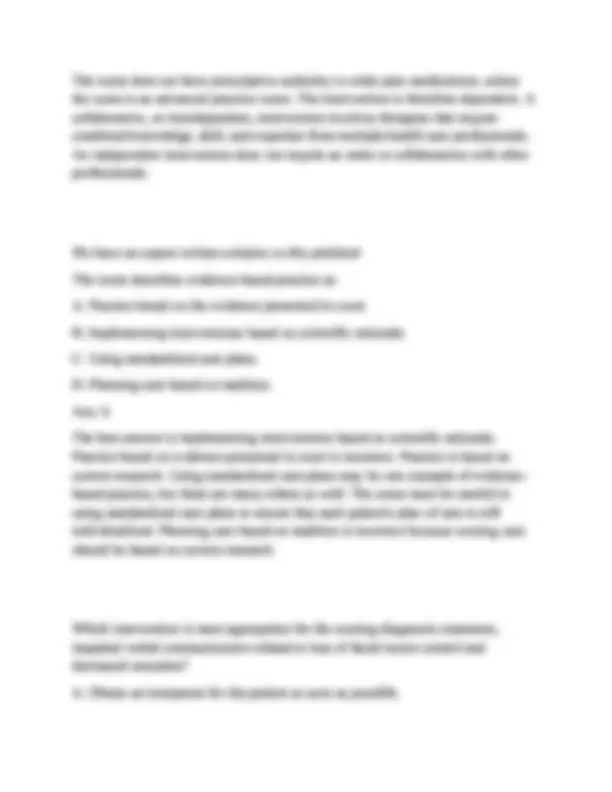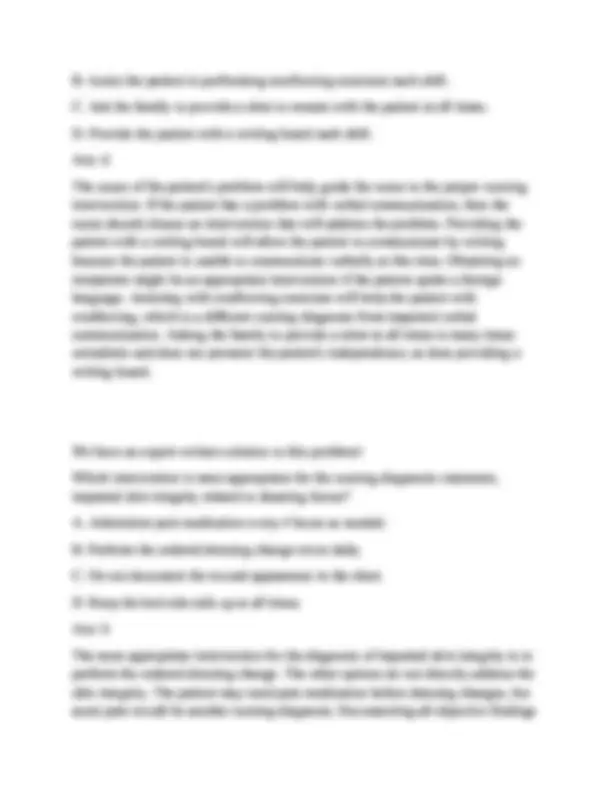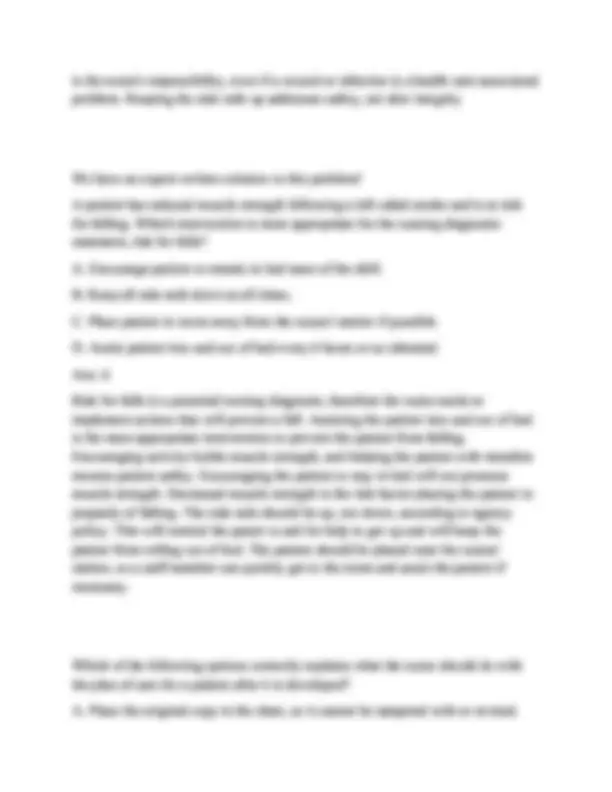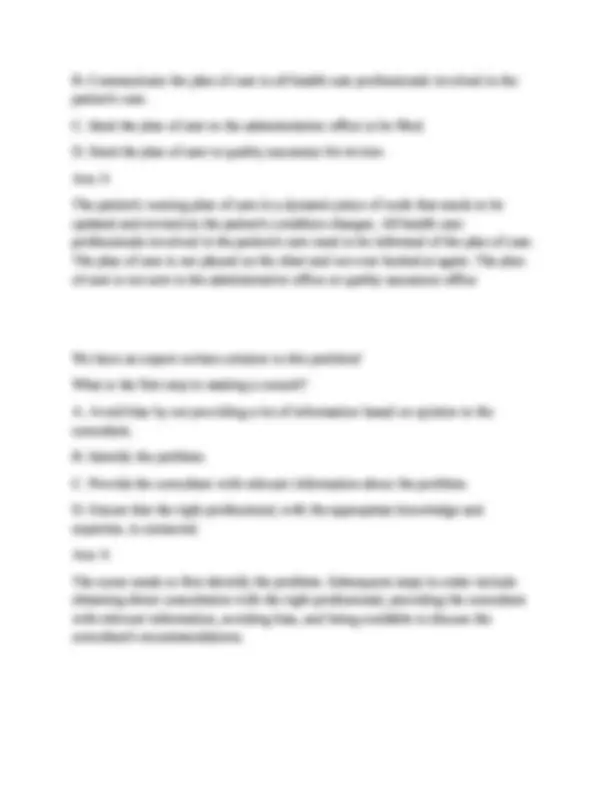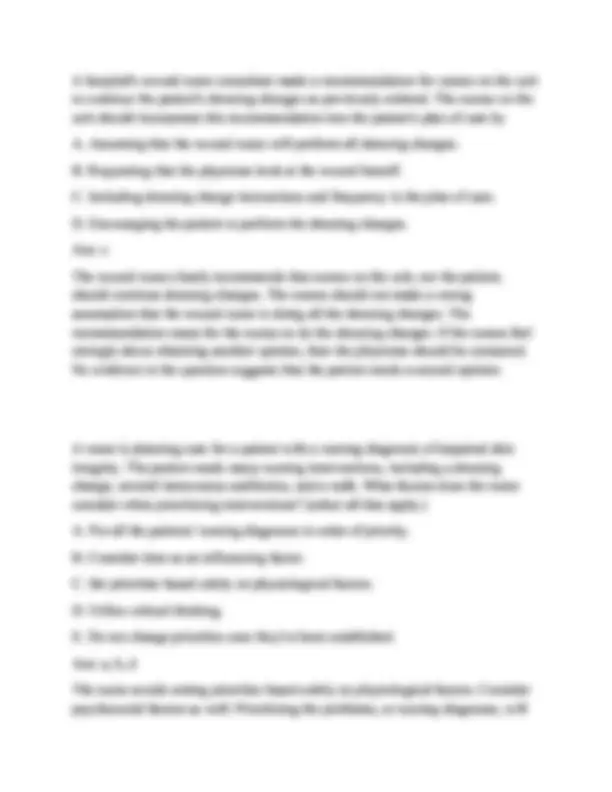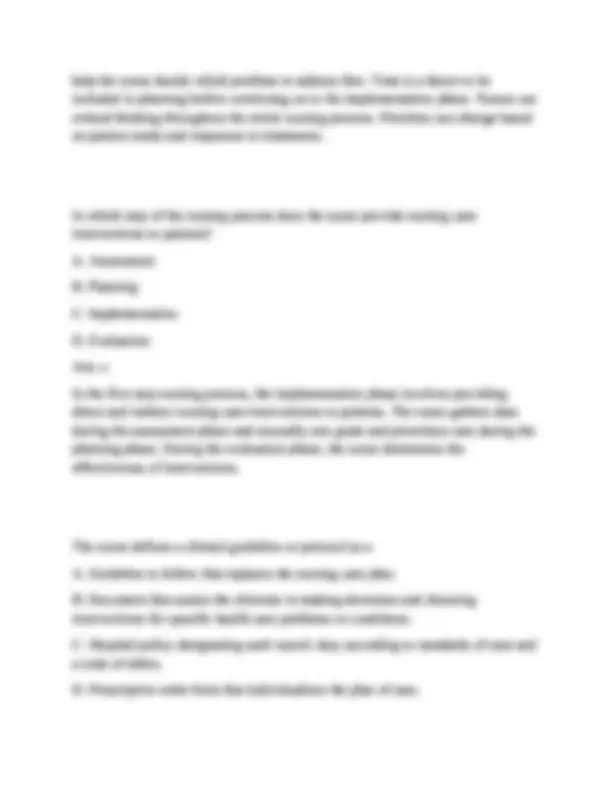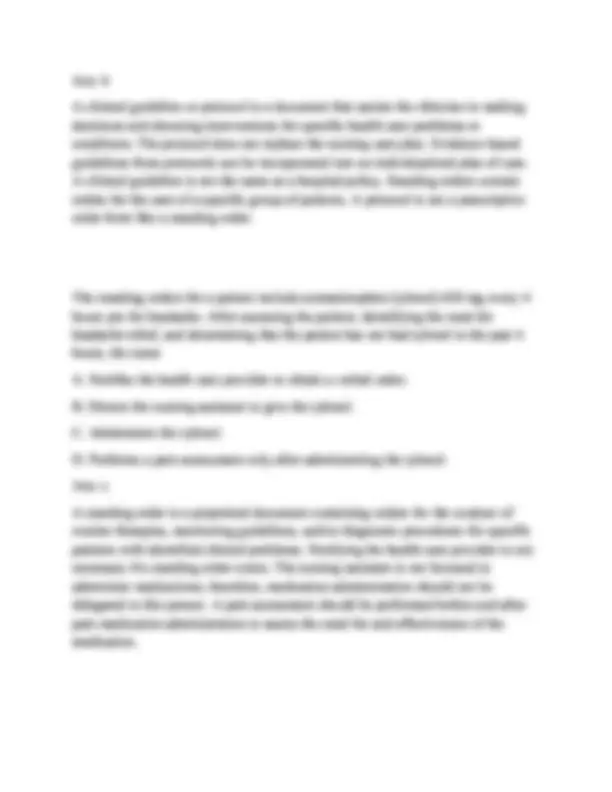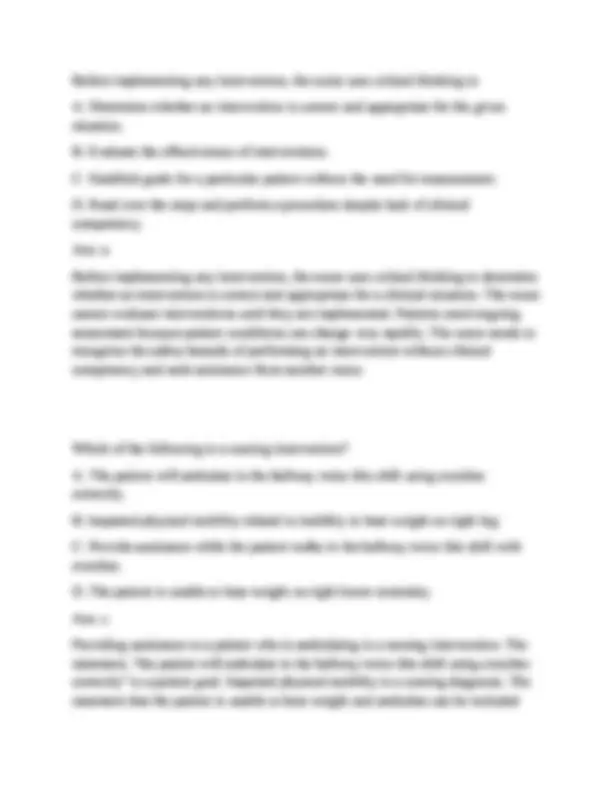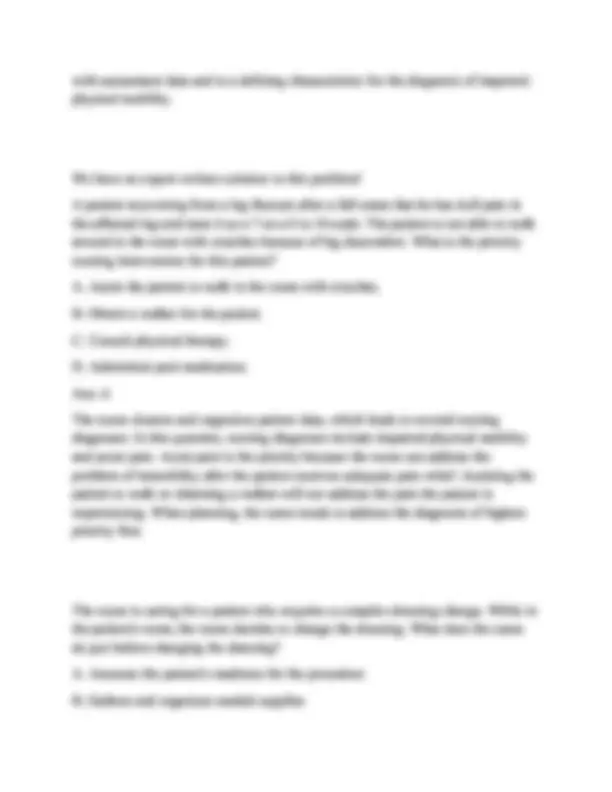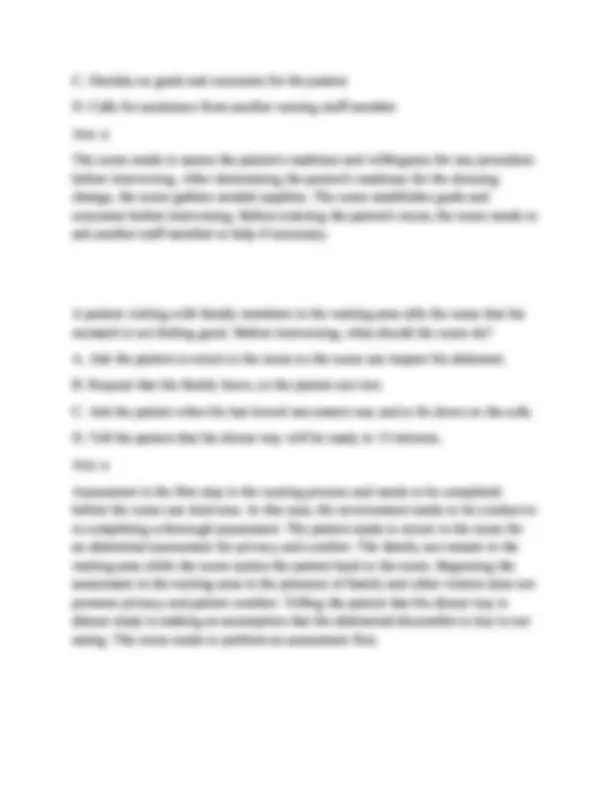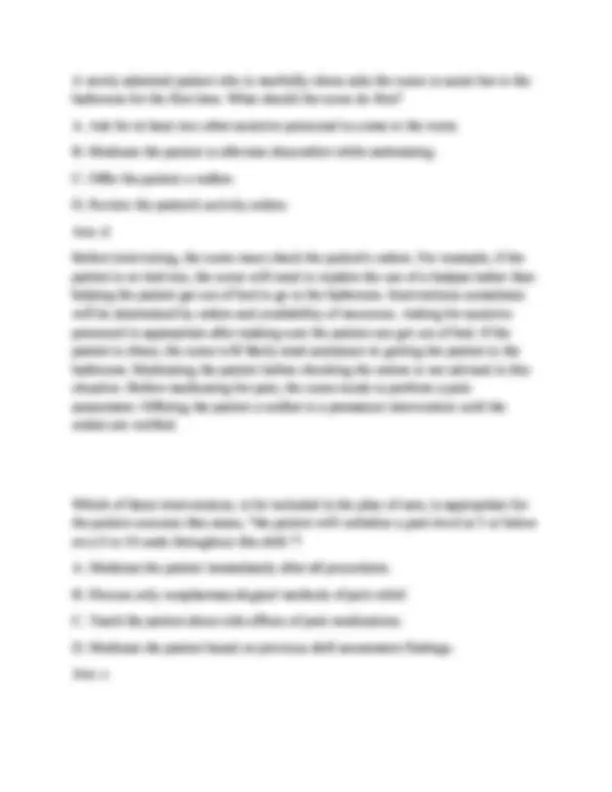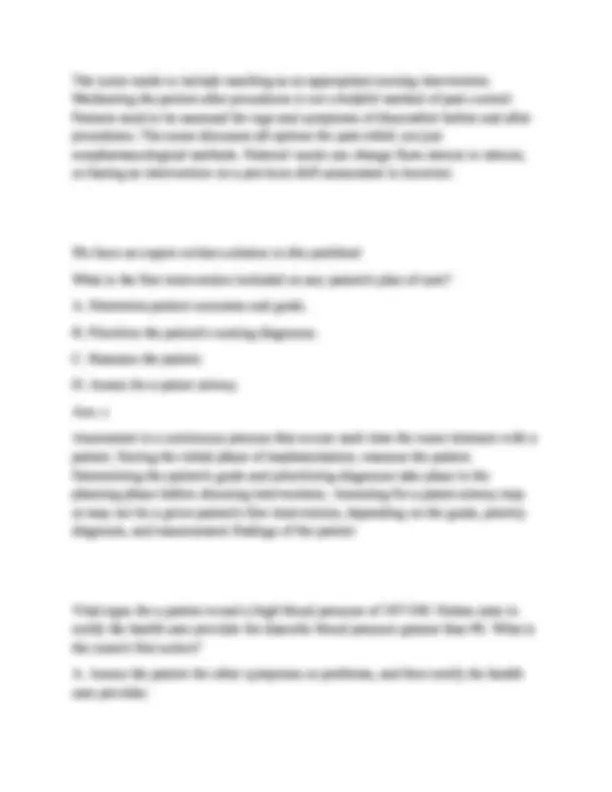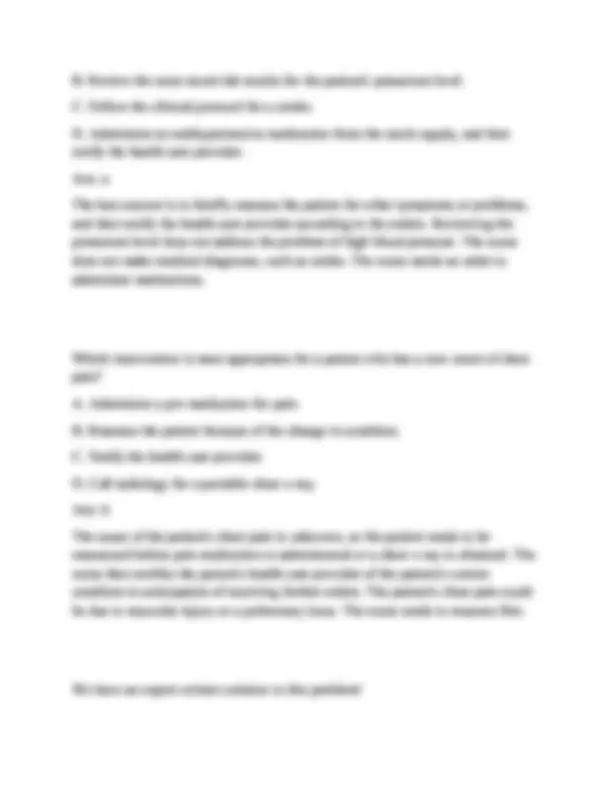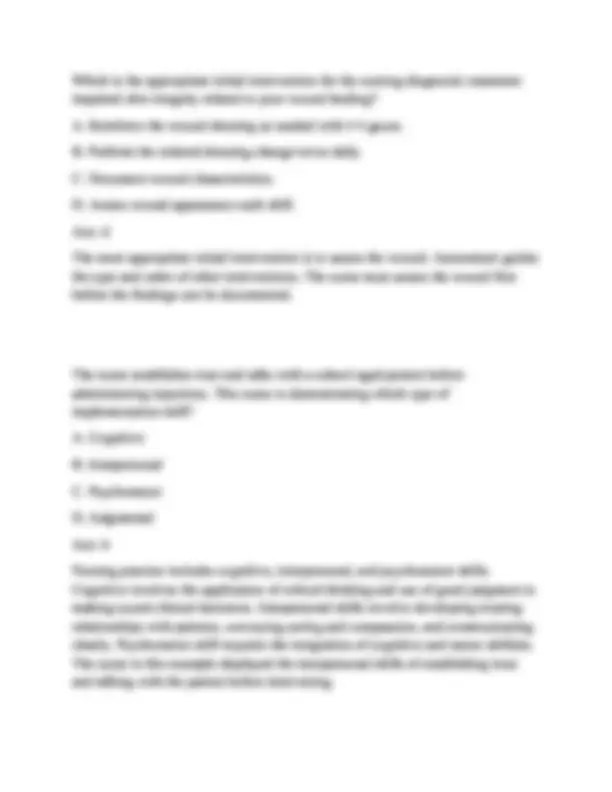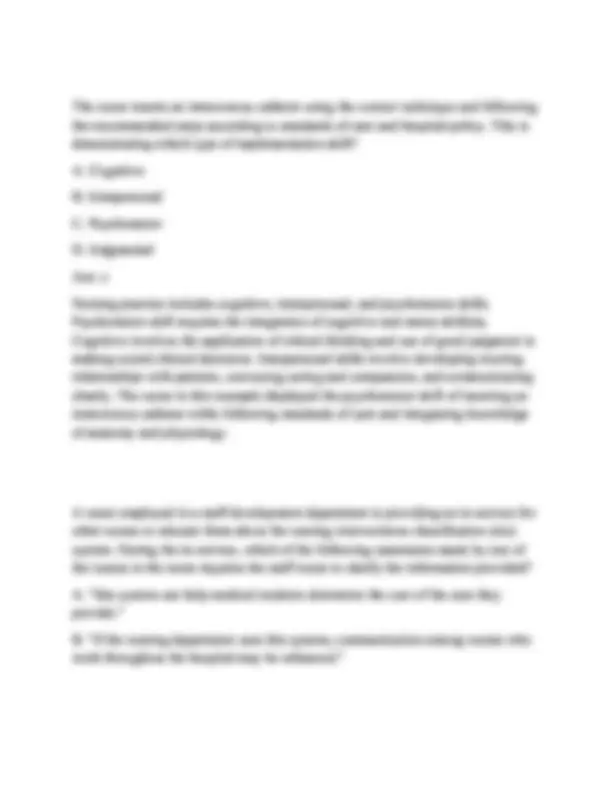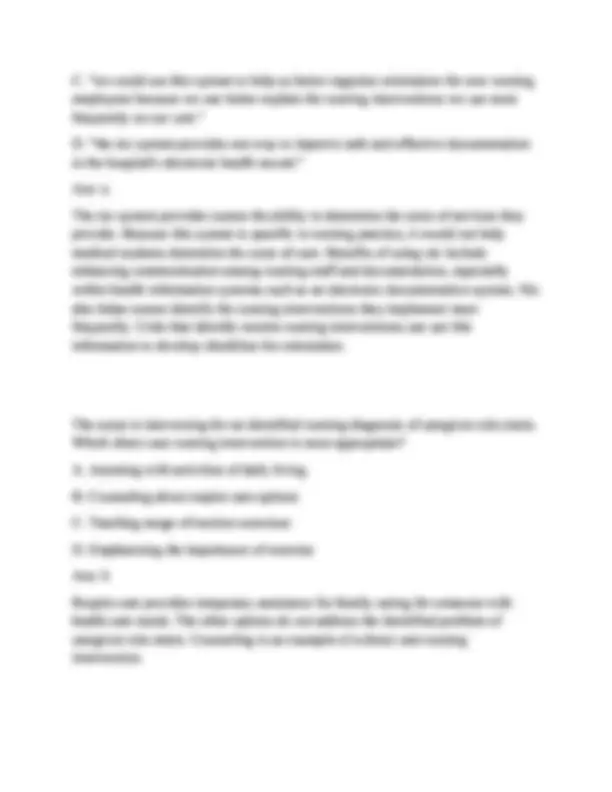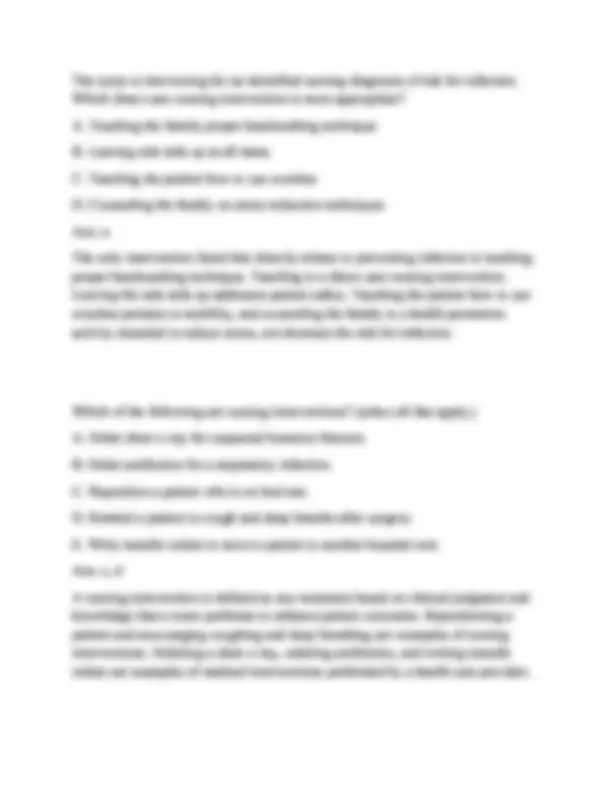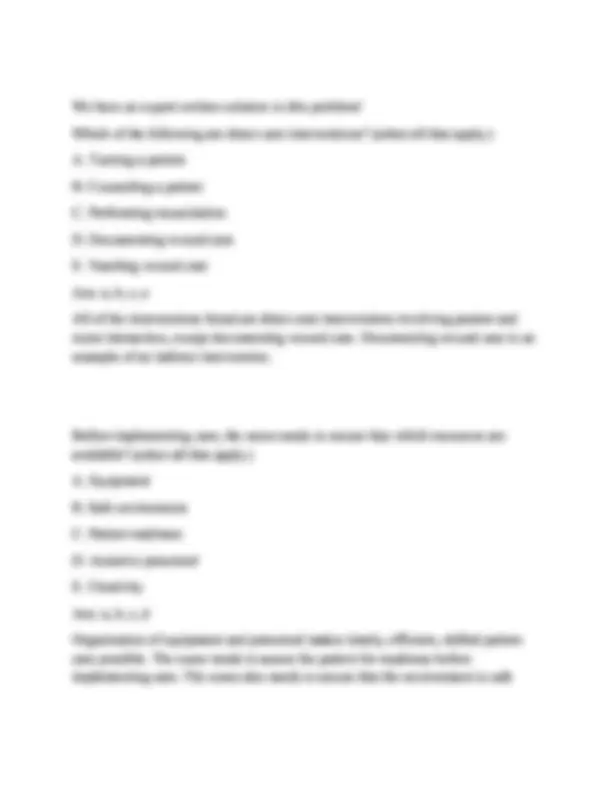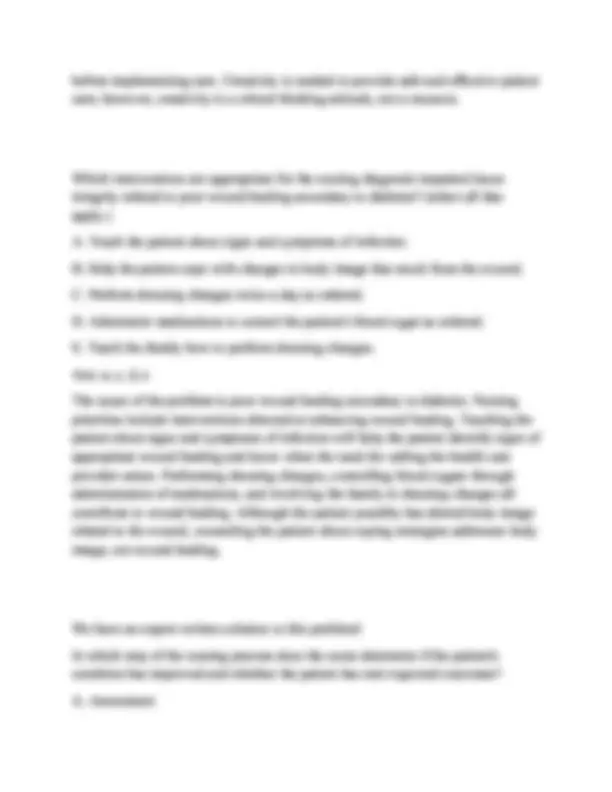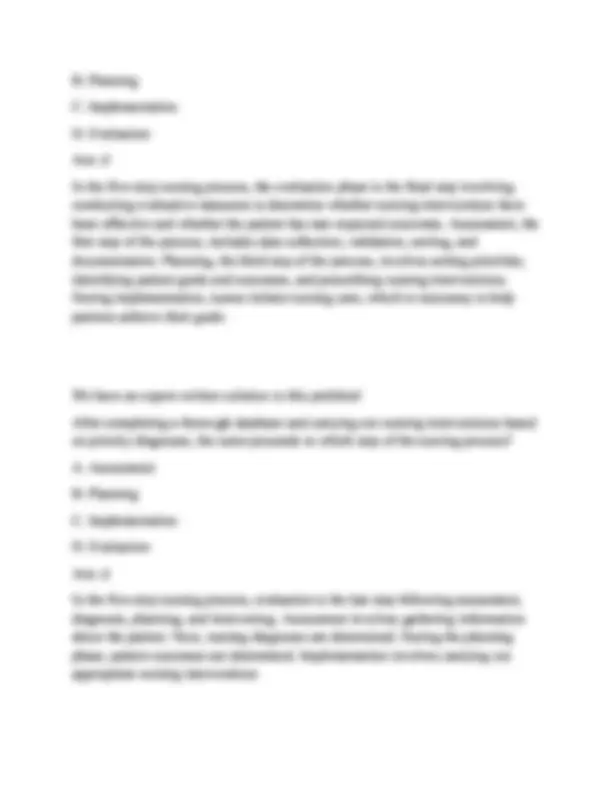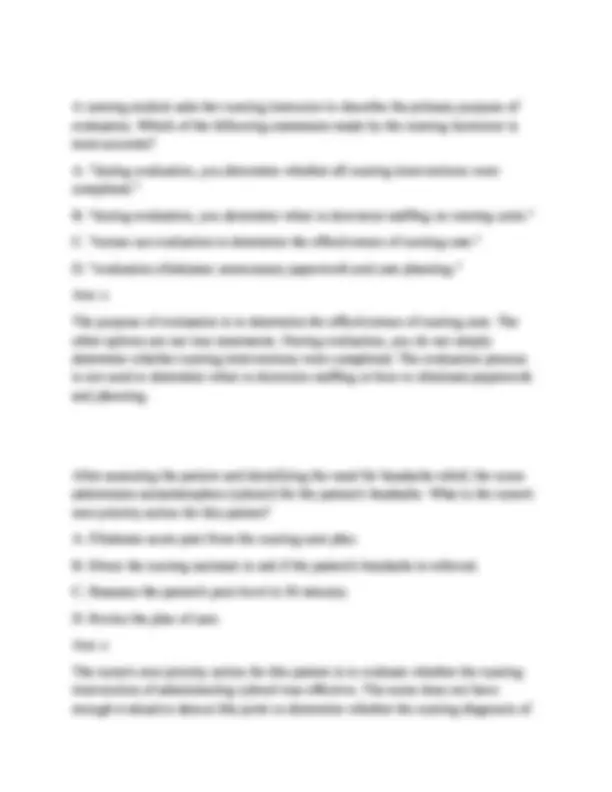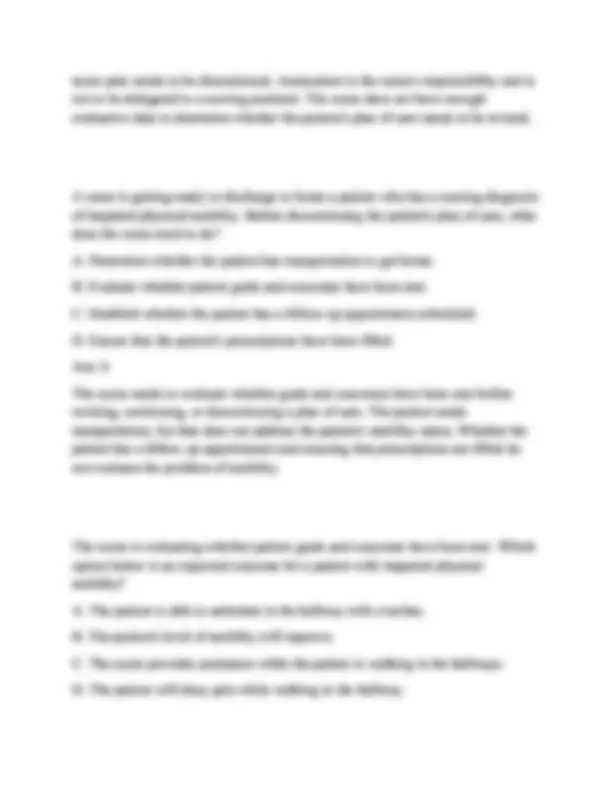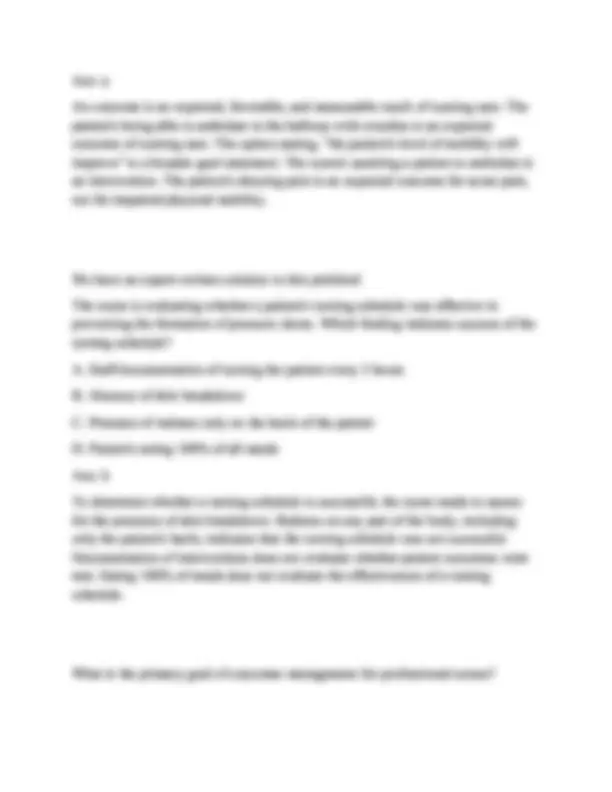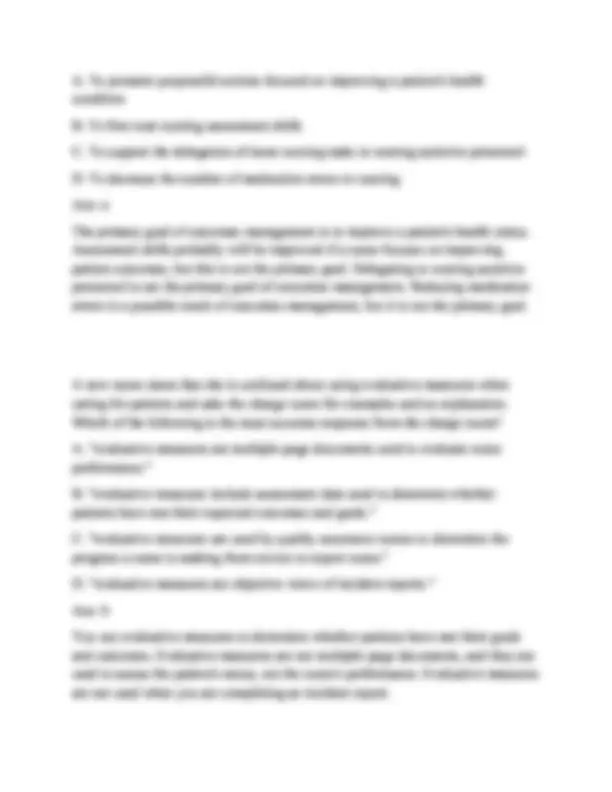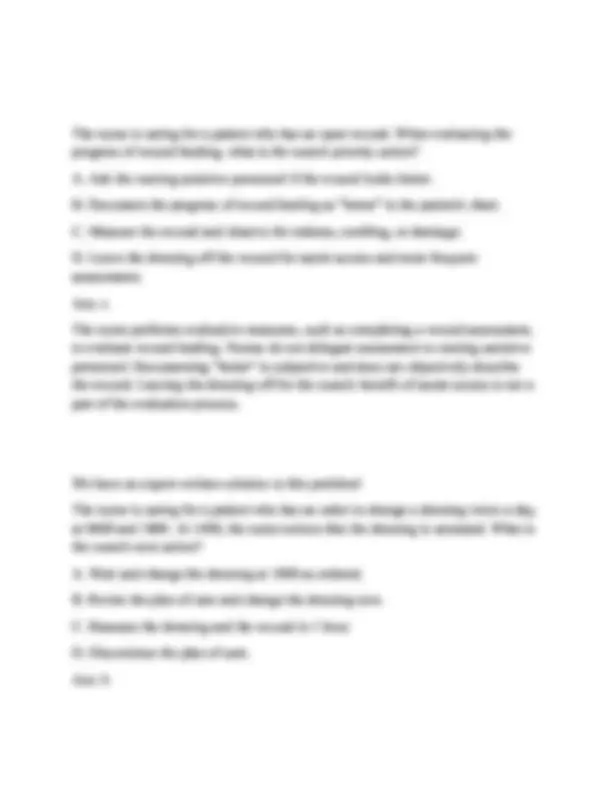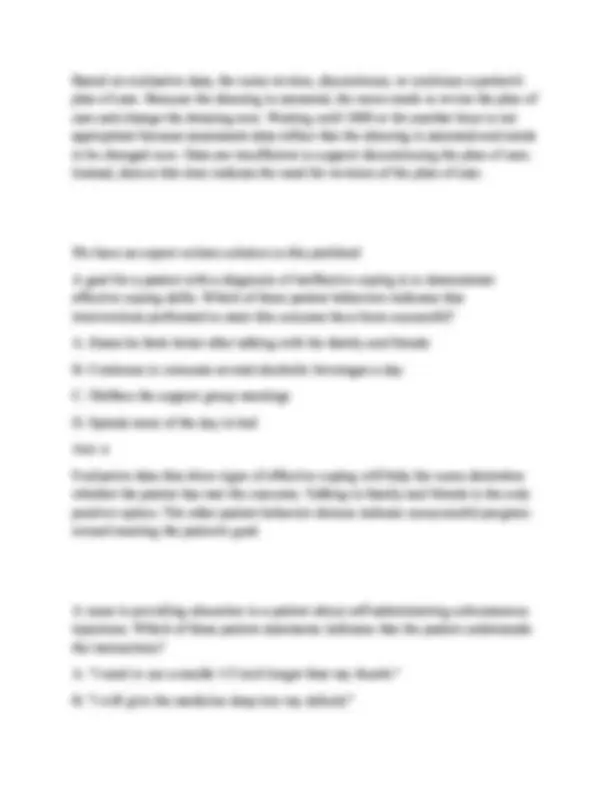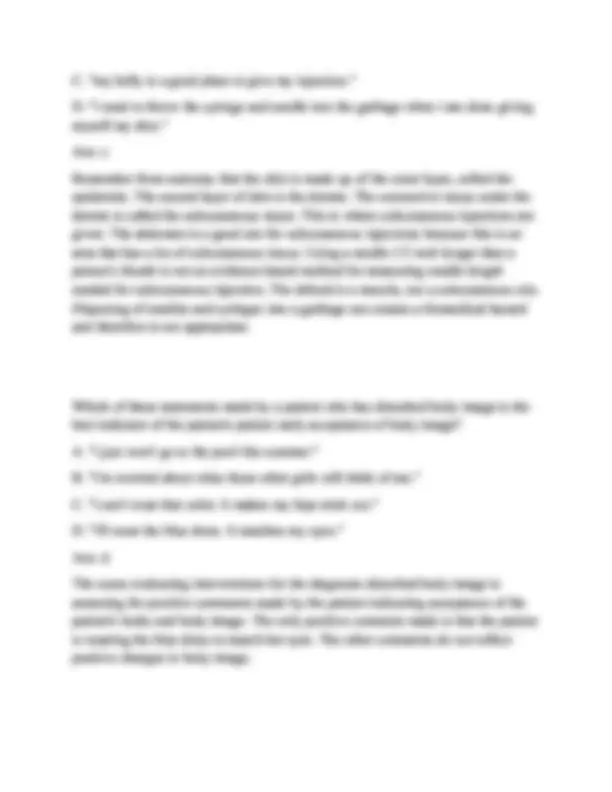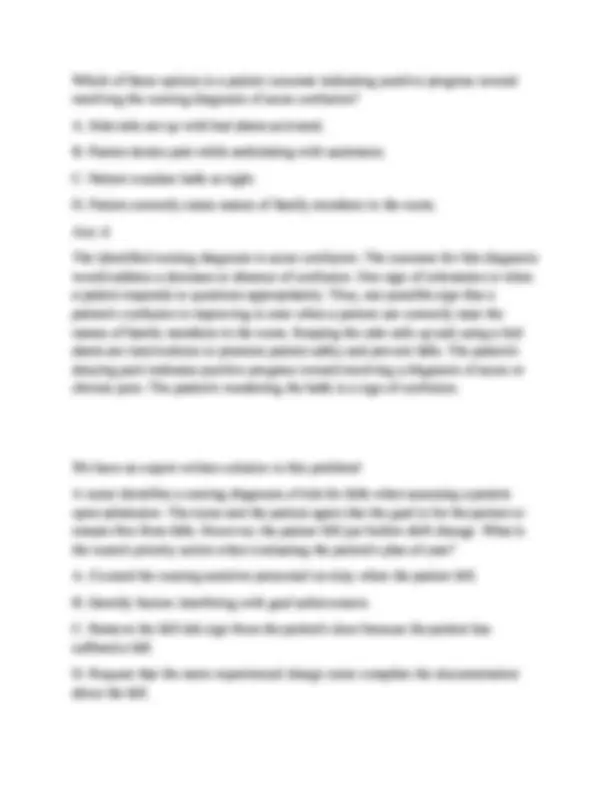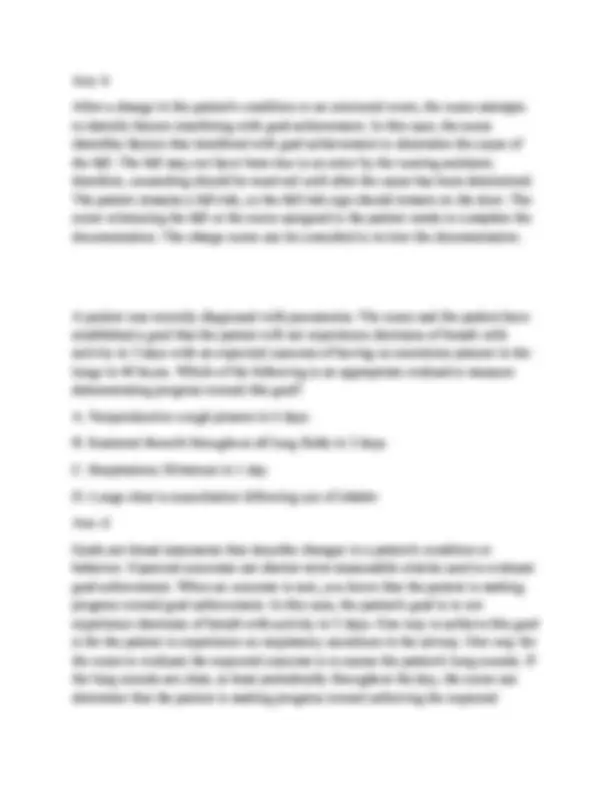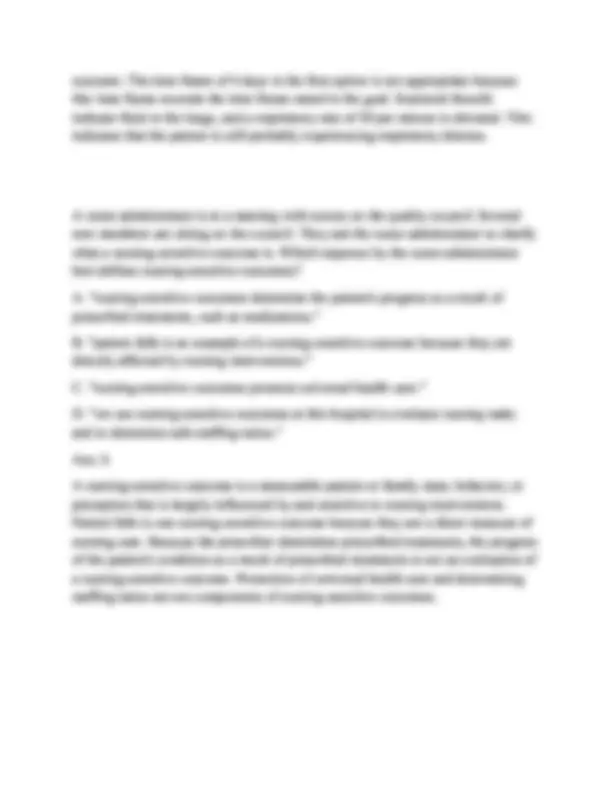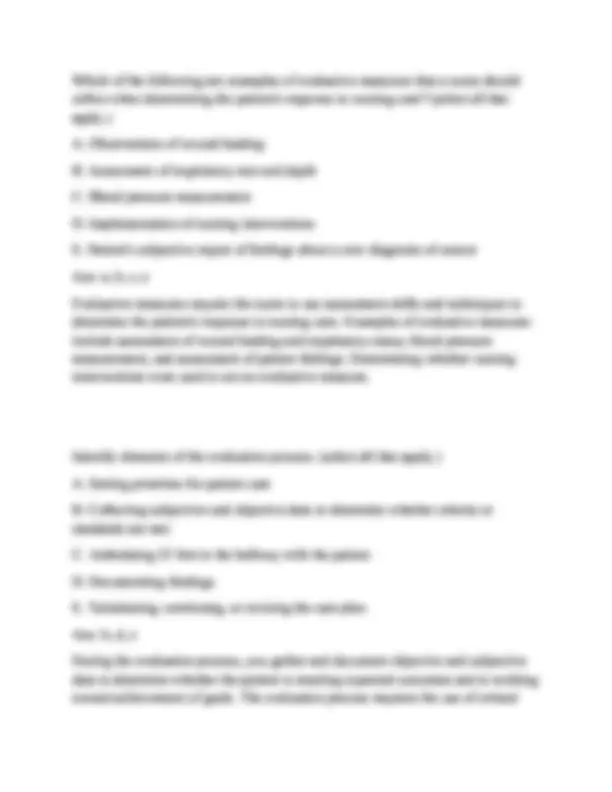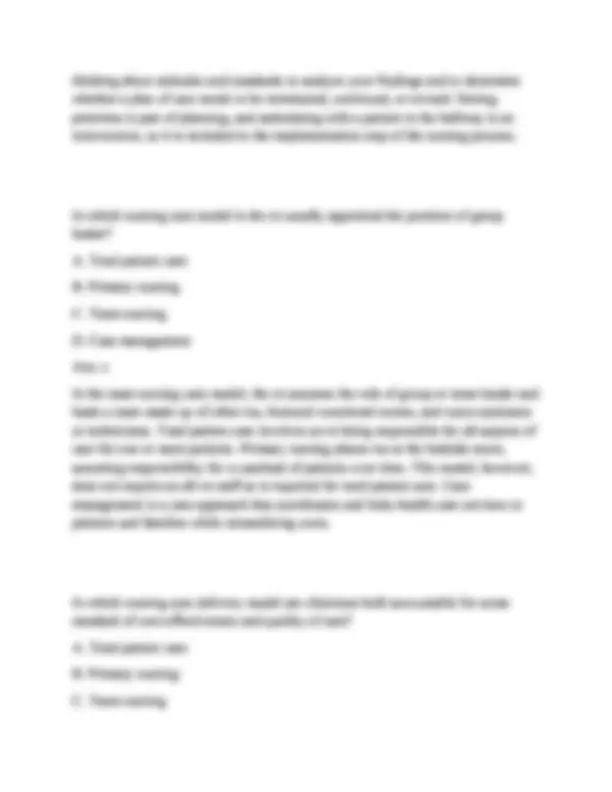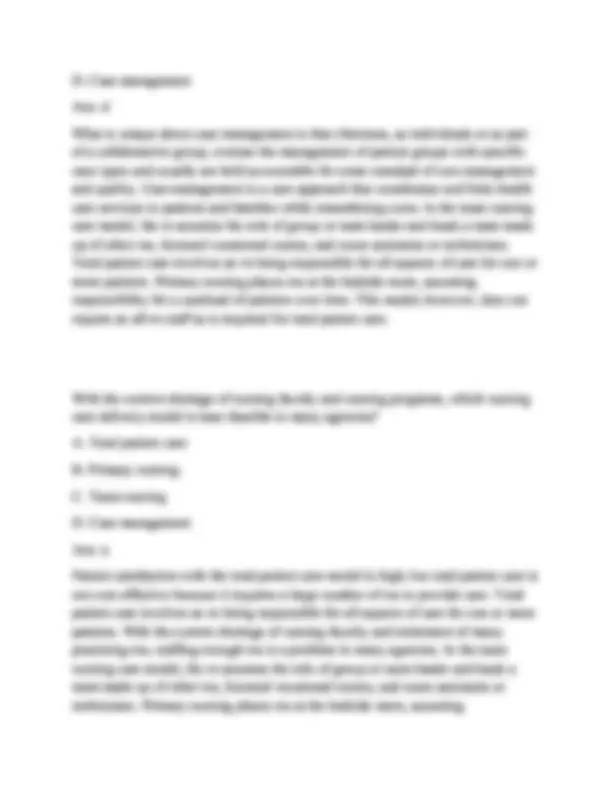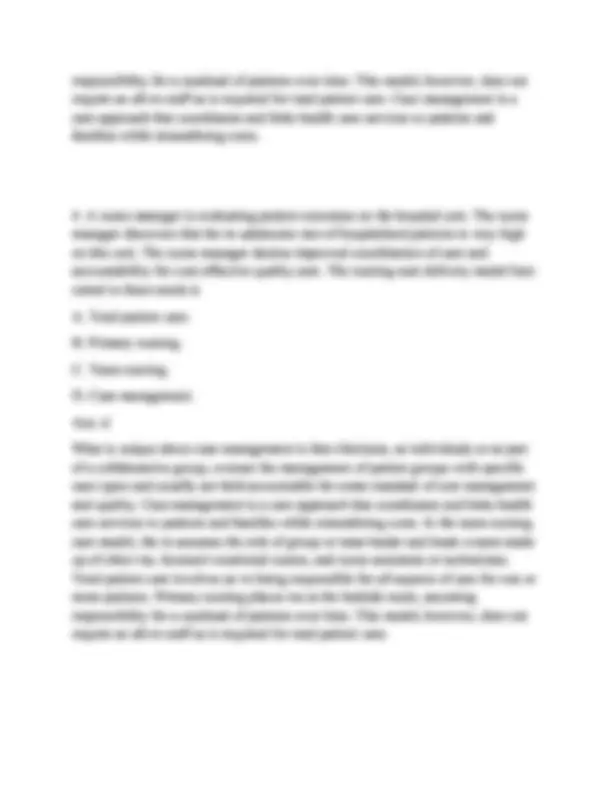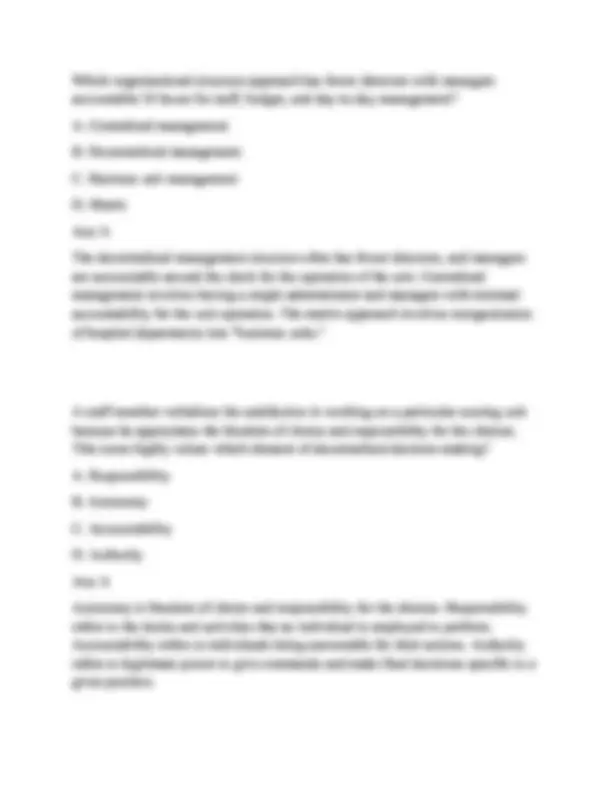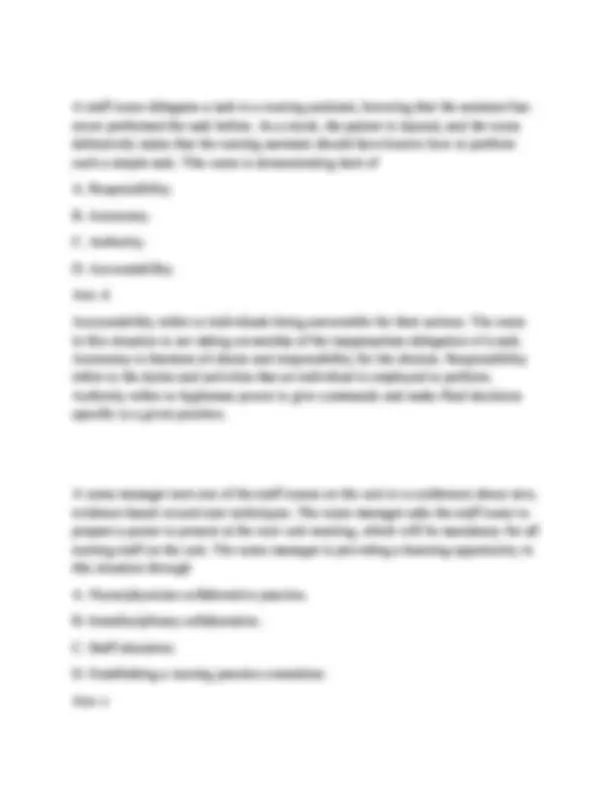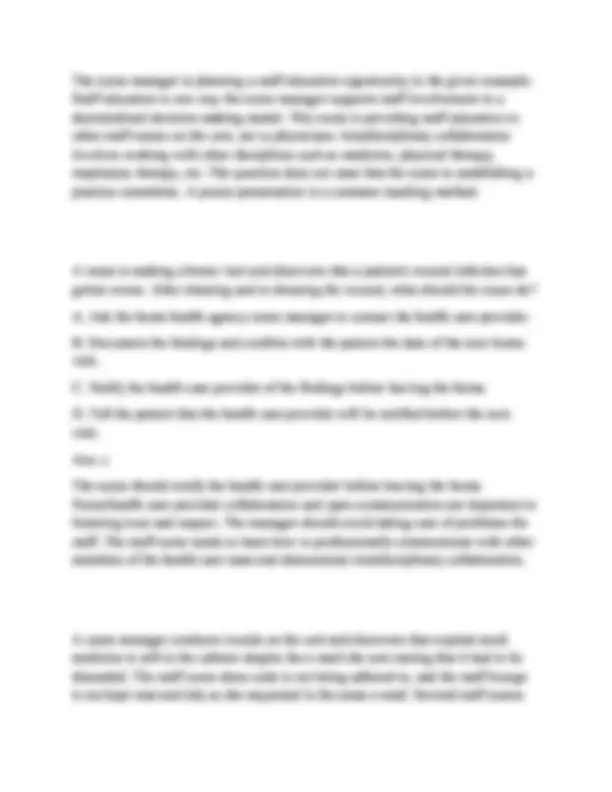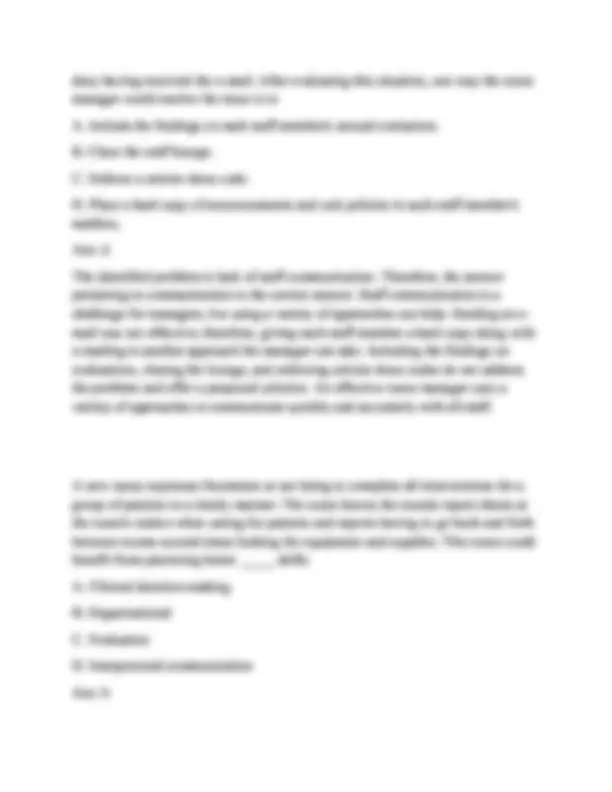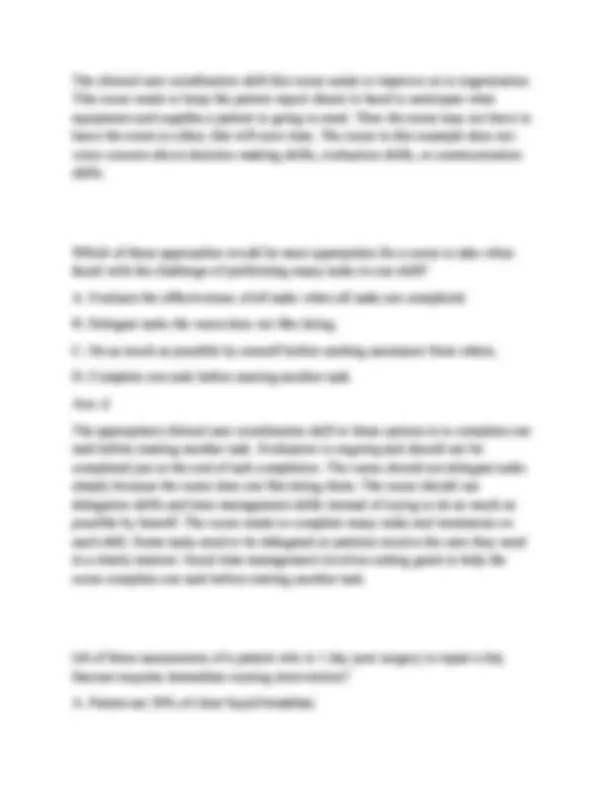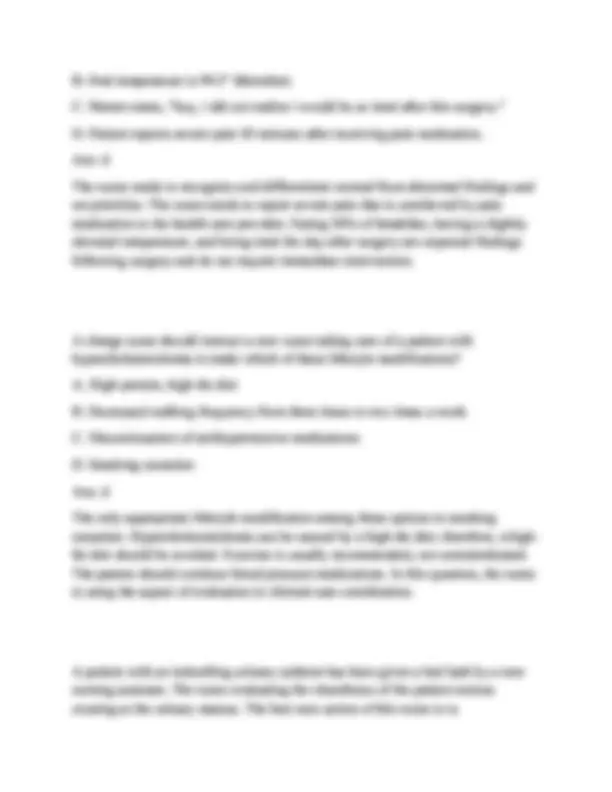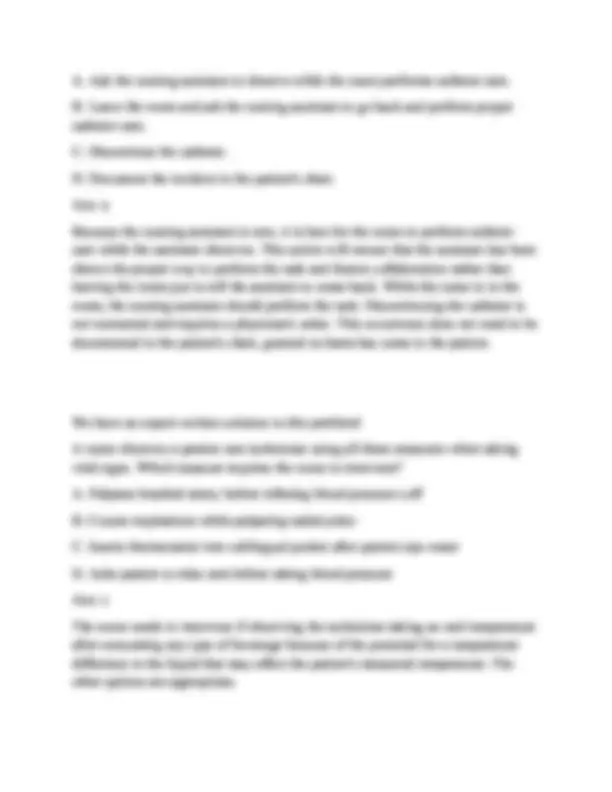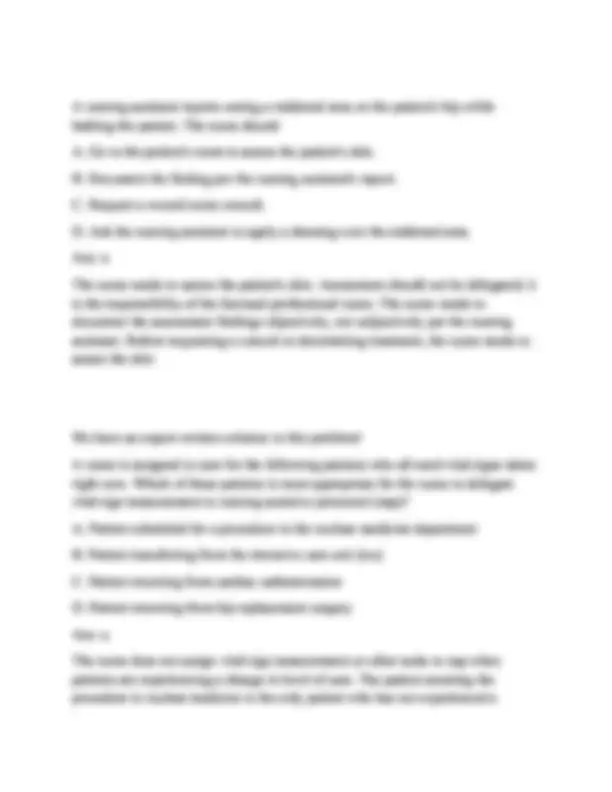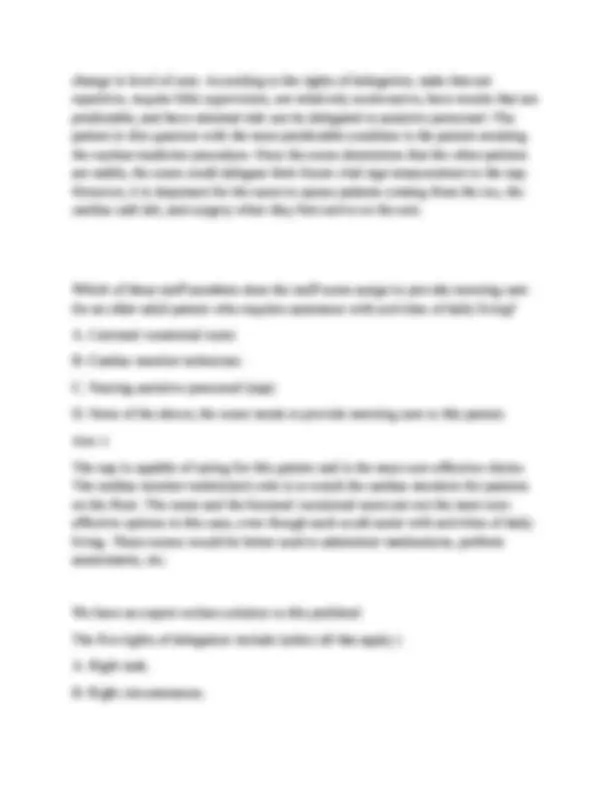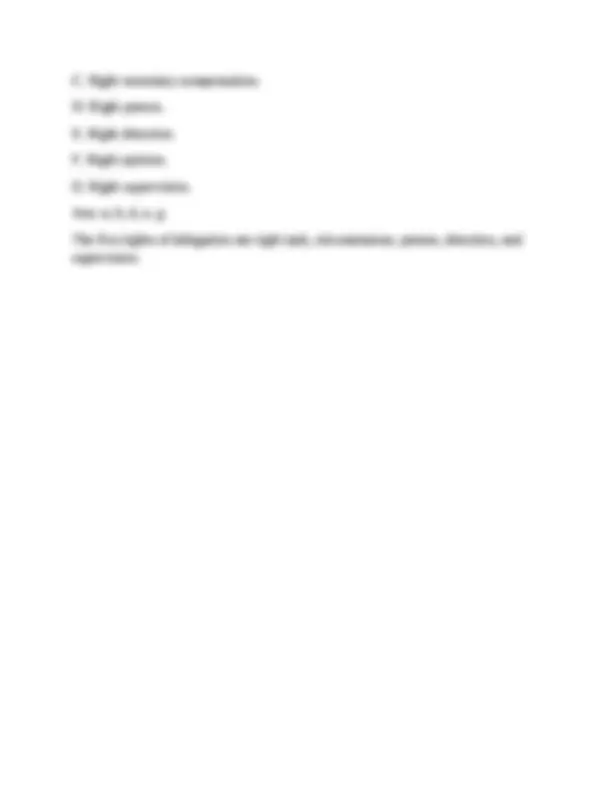Partial preview of the text
Download FUNDAMENTALS NURS 110 100 QUESTIONS WITH CORRECT AND VERIFIED ANSWERS. A+ GRADED. and more Exams Nursing in PDF only on Docsity!
A+ GRADED. Critical thinking characteristics include A. Considering what is important in a given situation. B. Accepting one, established way to provide patient care. C. Making decisions based on intuition. D. Being able to read and follow physician's orders. Ans: a Critical thinking involves being able to decipher what is relevant and important in a given situation and to make a clinical decision based on that importance. Patient care can be provided in many ways. Clinical decisions should be based on evidence and research. Following physician's orders is not considered a critical thinking skill. Which of these patient scenarios is most indicative of critical thinking? A. Administering pain relief medication according to what was given last shift B. Asking a patient what pain relief methods, pharmacological and nonpharmacological, have worked in the past C. Offering pain relief medication based on physician orders D. Explaining to the patient that his reports of severe pain are not consistent with the minor procedure that was performed Ans: b Asking the patient what pain relief methods have worked in the past is an example of exploring many options for pain relief. Administering medication based on a previous assessment is not practicing according to standards of care. The nurse is to conduct an assessment each shift on his/her patient and intervene accordingly. Nonpharmacological pain relief methods are available, as are medications for pain. Pain is subjective. The nurse should offer pain relief methods based on the patient's reports without being judgmental. Professional nurses are responsible for making clinical decisions to A. Prove traditional methods of providing nursing care to patients. B. Take immediate action when a patient's condition worsens. C. Apply clear textbook solutions to patients' problems. D. Formulate standardized care plans for groups of patients. Ans: b Professional nurses are responsible for making clinical decisions to take immediate action when a patient's condition worsens. Patient care should be based on evidence-based practice, not on tradition. Clear textbooks solutions to patient problems are not always available. Care plans should be individualized. The nurse needs a reminder of professional responsibility when performing which of these actions? A. Making an informed clinical decision B. Making an ethical clinical decision C. Making a clinical decision in the patient's best interest D. Making a clinical decision based on previous shift assessments D. Lecture and discussion Ans: a Concept maps challenge the student to synthesize data and identify relationships between nursing diagnoses. Reflective journaling involves thinking back to clarify concepts. Reading assignments and lecture do not best provide an instructor the ability to evaluate students' abilities to synthesize data. What is the first component of the critical thinking model for clinical decision making? A. Experience B. Nursing process C. Attitude D. A scientific knowledge base Ans: d A scientific knowledge base is the first component for clinical decision making. After acquiring a sound knowledge base, the nurse can then apply knowledge to different clinical situations using the nursing process to gain valuable experience. A critical thinking attitude is a guideline for how to approach a problem and apply knowledge to make a clinical decision. We have an expert-written solution to this problem! A new graduate nurse will make the best clinical decisions by applying the components of the nursing critical thinking model and which of the following? A. Drawing on past clinical experiences to formulate standardized care plans B. Relying on recall of information from past lectures and textbooks C. Depending on the charge nurse to determine priorities of care D. Using the nursing process Ans: d Using the nursing process along with applying components of the nursing critical thinking model will help the new graduate nurse make the most appropriate clinical decisions. Care plans should be individualized, and recalling facts does not utilize critical thinking skills to make clinical decisions. The new nurse should not rely on the charge nurse to determine priorities of care. The critical thinking skill of evaluation in nursing practice can be best described as A. Examining the meaning of data. B. Reviewing the effectiveness of nursing actions. C. Supporting findings and conclusions. D. Searching for links between data and the nurse's assumptions. Ans: b Reviewing the effectiveness of interventions best describes evaluation. Examining the meaning of data is inference. Supporting findings and conclusions provides explanations. Searching for links between the data and the nurse's assumptions describes analysis. The patient appears to be in no apparent distress, but vital signs taken by assistive personnel reveal an extremely low pulse. The nurse then auscultates an apical pulse and asks the patient whether he has any complaints or a history of heart problems. The nurse is utilizing which critical thinking skill? A. Interpretation The nursing student can best develop critical thinking skills by doing which of the following? A. Studying 3 hours more each night B. Actively participating in all clinical experiences C. Interviewing staff nurses about their nursing experiences D. Attending all open skills lab opportunities Ans: b Nursing is an applied science, and to apply knowledge learned and develop critical thinking skills to make clinical decisions, the student should actively participate in all clinical experiences. Studying for longer hours, interviewing nurses, and attending skills labs do not provide opportunities for clinical decision making, as do actual clinical experiences. While caring for a hospitalized older adult female post hip surgery, the new graduate nurse is faced with the task of inserting an indwelling urinary catheter, which involves rotating the hip into a contraindicated position. The nurse exhibits critical thinking to perform this task by A. Following textbook procedure. B. Notifying the physician of the need for a urologist consult. C. Adapting the positioning technique to the situation. D. Postponing catheter insertion until the next shift. Ans: c The nurse must use critical thinking skills in this situation to adapt positioning technique. In practice, patient procedures are not always presented as in a textbook, but they are individualized. A urologist consult is not warranted for position, but perhaps instead for difficulty in insertion. Postponing insertion of the catheter is not an appropriate action. The nurse enters a room to find the patient sitting up in bed crying. How would the nurse display a critical thinking attitude in this situation? A. Tell the patient she'll be back in 30 minutes. B. Set a box of tissues at the patient's bedside before leaving the room. C. Ask the patient why she is crying. D. Limit visitors while the patient is upset. Ans: c The nurse should try to find out why the patient is crying to intervene appropriately. Telling the patient that she will return, providing tissues, and limiting visitors may be appropriate actions but do not address the reason why the patient is crying. A patient is having trouble reaching the water fountain while holding on to crutches. The nurse suggests that the patient place the crutches against the wall while stabilizing himself with two hands on the water fountain. Which critical thinking attitude is utilized in this situation? A. Humility B. Confidence C. Risk taking D. Creativity Ans: d C. Requiring the nurse to use critical thinking for the highest level of quality nursing care. D. Utilizing evidence-based practice based on nurses' needs. Ans: c Upholding professional standards requires nurses to use critical thinking for the highest level of quality nursing care. Bypassing the patient's feelings is not practicing according to professional standards. The primary purpose of professional standards is not to establish minimal passing standards for testing. Patient care should be based on patient needs, not on nurses' needs. A nurse who is caring for a patient with a pressure ulcer fails to apply the recommended dressing according to hospital policy. If the patient is harmed, the nurse could be subject to legal action for not adhering to A. Fairness. B. Intellectual standards. C. Independent reasoning. D. Institutional practice guidelines. Ans: d Institutional practice guidelines are established standards and policies that can be used in court to make judgments about nursing actions. Intellectual standards are guidelines or principles for rational thought. Fairness and independent reasoning are two examples of critical thinking attitudes that are designed to help nurses make clinical decisions. Which of these findings, if identified in a plan of care, should the registered nurse revise because it is not characteristic of critical thinking and the nursing process? A. Patient's reactions to diagnostic testing B. Nurse's assumptions about hospital discharge C. Identification of five different nursing diagnoses D. Documentation of patient's ability to cope with loss Ans: b The nurse should not assume when a patient is going to be discharged and document this information in a plan of care. Making assumptions is not an example ofa critical thinking skill. The patient's reactions to testing, having several nursing diagnoses, and a description of the patient's coping abilities are all appropriate to document in the nursing plan of care. The nursing process involves which of the following steps in the clinical decision- making process? (select all that apply.) A. Identifying patient needs B. Diagnosing the disease process C. Determining priorities of care D. Setting goals E. Performing nursing interventions F. Evaluating effectiveness of medical treatments Ans: a, c, d, € Diagnosing disease is not a nursing action. Evaluating the effectiveness of medical treatments is not a nursing action either. Nurses are to use the nursing process to evaluate the effectiveness of nursing interventions, not medical treatments. Identifying patient needs, determining priorities of care, setting realistic goals, and implementing nursing interventions are all steps in the clinical decision-making process. interpretation occurs while appropriate nursing diagnoses are assigned. The question is asking about data collection. After reviewing the database, the nurse discovers that the patient's vital signs have not been recorded by the nursing assistant. With this in mind, what clinical decision should the nurse make? A. Administer scheduled medications assuming she would have been informed if the vital signs were abnormal. B. Have the patient transported to the radiology department for a scheduled x-ray, and review vital signs upon return. C. Ask the nursing assistant to record the patient's vital signs before administering medications. D. Omit the vital signs because the patient is presently in no distress. Ans: ¢ The nurse should ask the nursing assistant to record the vital signs for review before administering medicines or transporting the patient to another department. The nurse should not make assumptions when providing high-quality patient care, and omitting the vital signs is not an appropriate action. We have an expert-written solution to this problem! Subjective data include A. A patient's feelings, perceptions, and reported symptoms. B. A description of the patient's behavior. C. Observations of a patient's health status. D. Measurements of a patient's health status. Ans: a Subjective data include the patient's feelings, perceptions, and reported symptoms. Only patients provide subjective data relevant to their health condition. Data sometimes reflect physiological changes, which you further explore through objective data collection. Describing the patient's behavior, observations made, and measurements of a patient's health status are all examples of objective data. We have an expert-written solution to this problem! A patient expresses fear of going home and being alone. Her vital signs are stable and her incision is nearly completely healed. The nurse can infer from the subjective data that A. The patient can now perform the dressing changes herself. B. The patient can begin retaking all her previous medications. C. The patient is apprehensive about discharge. D. Surgery was not successful. Ans: c Subjective data include expressions of fear of going home and being alone. These data indicate that the patient is apprehensive about discharge. Expressing fear is not an appropriate sign that a patient is able to perform dressing changes independently. An order from a health care provider is required before a patient is taught to resume previous medications. The nurse cannot infer that surgery was not successful if the incision is nearly completely healed. Which of the following methods of data collection is utilized to establish a patient's nursing database? A. Notify the physician to recommend a psychological evaluation. B. Consider cultural differences during this assessment. C. Ask the patient to make eye contact to determine her affect. D. Continue with the interview and document that the patient is depressed. Ans: b Older women of asian descent consider it rude to look an authority figure, such as a health care professional, in the eye. This nurse needs to practice culturally competent care and appreciate the cultural differences. Assuming that the patient is depressed or in need of a psychological evaluation is inappropriate. After setting the agenda during a patient-centered interview, what will the nurse do? A. Begin by introducing himself. B. Conduct a nursing health history. C. Explain that the interview will be over in a few more minutes. D. Tell the patient that he'll be back to administer medications in 1 hour. Ans: b After setting the agenda, the nurse should conduct the actual interview and proceed with data collection. Setting the stage begins with introductions and takes place before an agenda is set. The termination phase includes telling the patient when the interview is nearing an end. Telling the patient medications will be given later when the nurse returns would typically take place during the termination phase of the interview. The nurse is attempting to prompt the patient to elaborate on her complaints of daytime fatigue. Which question should the nurse ask? A. "is there anything that you are stressed about right now?" B. "what reasons do you think are contributing to your fatigue?" C. "what are your normal work hours?" D. "are you sleeping 8 hours a night?" Ans: b The question asking the patient what factors might be contributing to her fatigue will elicit the best open-ended response. Asking whether the patient is stressed and asking if the patient is sleeping 8 hours a night are closed-ended questions eliciting simple yes or no responses. Asking about normal works hours will elicit a matter- of-fact response and does not prompt the patient to elaborate on her complaints of daytime fatigue nor ask about the contributing reasons. Components of a nursing health history include A. Current treatment orders. B. Nurse's concerns. C. Nurse's goals for the patient. D. Patient expectations. Ans: d Components of a nursing health history include physical examination findings, patient expectations, environmental history, and diagnostic data. Current treatment orders are located under the orders section in the patient's chart and are not a part of the nursing health history. Patient concerns, not nurse's concerns, are included in the database. Goals that are mutually established, not nurse's goals, are part of the nursing care plan. hand and performs a problem-oriented assessment. Utilizing gordon's functional health patterns is an example of a structured database-type assessment technique. The nurse in this question is performing a specific problem-oriented assessment approach. The nurse is not performing an activity-exercise pattern assessment in this question. A nurse comparing data validation and data interpretation correctly explains the difference with which statement? A. "validation involves looking for patterns in professional standards." B. "data interpretation involves discovering patterns in professional standards." C. "validation involves comparing data with other sources for accuracy." D. "data interpretation occurs before data validation." Ans: c Validation, by definition, involves comparing data with other sources for accuracy. Data interpretation involves identifying abnormal findings, clarifying information, and identifying patient problems. The nurse should validate data before interpreting the data and making inferences. The nurse is interpreting and validating patient data, not professional standards. Which scenario best illustrates the use of data validation when making an independent nursing clinical decision? A. The nurse determines that she needs to remove a wound dressing when the patient reveals the time of the last dressing change, and she notices that the present dressing is saturated with fresh and old blood. B. The nurse administers pain medicine due at 1700 at 1600 because the patient complains of increased pain. C. The nurse removes a leg cast when the patient complains of decreased mobility. D. The nurse administers potassium when a patient complains of leg cramps. Ans: a Changing the wound dressing is the only independent nursing action given. The nurse validates what the patient says with her own observation of the dressing. This option is the only assessment option as well that involves data validation. Administering pain medicine or potassium and removing a leg cast are examples of nursing interventions. We have an expert-written solution to this problem! While completing an admission database, the nurse is interviewing a patient who states that he is allergic to latex. The most appropriate nursing action is to first A. Leave the room and place the patient in isolation. B. Ask the patient to describe the type of reaction. C. Proceed to the termination phase of the interview. D. Document the latex allergy on the medication administration record. Ans: b The nurse should further assess and ask the patient to describe the type of reaction. The patient will not need to be placed in isolation; before terminating the interview or documenting the allergy, health care personnel need to be aware of what type of response the patient suffered. A patient verbalizes a low pain level of 2 out of 10 but exhibits extreme facial grimacing while moving around in bed. What is the nurse's best action in response to her observation? 
